
Utah’s 18 th Governor Spencer J. Cox
Living the Utah Dream
A Force of Nature
Promoting tourism through responsible stewardship Pg. 11
Aerospace and Defense
A period of significant growth and expansion
Pg. 31
Rural Spotlight: Kanab
The origins of ‘Abra Kanabra’ Pg. 58
AN OFFICIAL PUBLICATION OF THE UTAH GOVERNOR’S OFFICE OF ECONOMIC OPPORTUNITY 2021





BUSINESS.UTAH.GOV | @BUSINESSUTAH I Contents Utah’s Tourism Industry: A Force of Nature Promoting tourism through responsible stewardship Aerospace and Defense A period of significant growth and expansion Rural Spotlight: Kanab The origins of ‘Abra Kanabra’ On the Cover Departments Utah Opportunities Targeted Industries 58 11 31 7 Utah’s Economy Amid a Pandemic 9 Corporate Recruitment Growth Results in Thousands of Utah Jobs 11 Utah’s Tourism Industry: A Force of Nature 13 Utah Film Industry Adapts to Pandemic 15 A Tent As Old As Time 18 Delivering Innovative Workforce Development Solutions for Utah 20 Building Bridges Between Business and Education 21 STRATA Connects Communities 23 29 23 What’s The Point? Utah’s Once-in-a-Lifetime Opportunity 25 Utah Inland Port Authority: Why Utah, Why Now? 28 Targeted Growth Through Collaboration: Utah’s Opportunity 29 Utah’s Entrepreneurial Spirit is at the Core of its Advanced Manufacturing Companies 31 Growth and Expansion Continues for Utah’s Aerospace and Defense Companies 34 Giving Utah Small Businesses and Entrepreneurs a Competitive Advantage 36 Utah: Green Energy Hub of the West 38 When It Comes To Banking, Utah Takes Center Stage 40 Life Sciences 42 Utah’s Science Guy 44 Opportunities Abound in Utah’s Software and Information Technology Arenas 73 BUSINESS.UTAH.GOV i
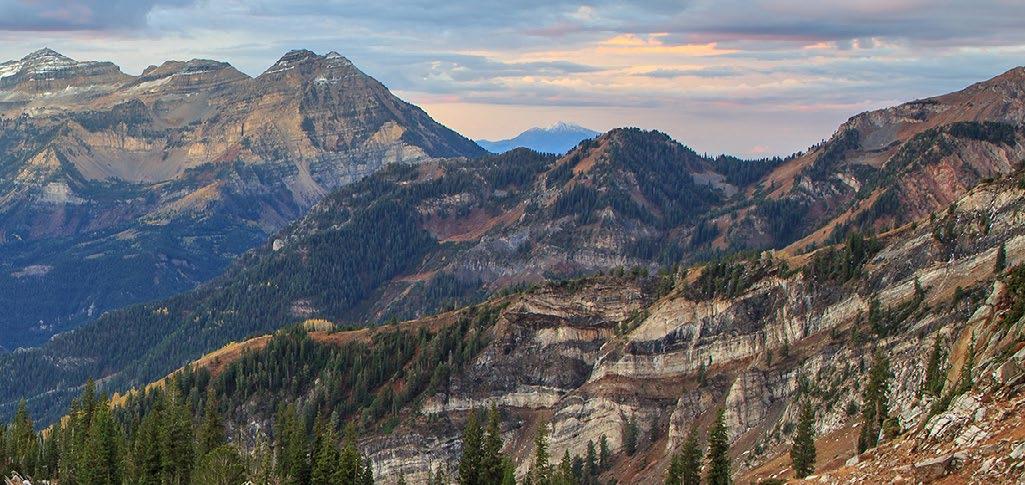

BUSINESS IN UTAH | 2021 II 50 Iron County Shines 53 Cache Valley: Economic Success at the Top of the State 55 Heber Valley: Reimagining Tourism’s Role in the Community 58 Abra Kanabra: The Magic of the West 61 Price: A Town of Endless Opportunities 63 Vernal’s Innovation Hub 65 Utah Regional Economic Development Offices Rural Utah Regional Spotlight Economic Development Partners Gov.
Letter from the Executive Director Contributors Credits About Go Utah Board of Directors 46 50 67 46 Rural Workforce Network Brings Economic Development Opportunities to Rural Utah 48 A Place for Remote Work in Rural Utah 73 Education 75 Workforce 77 Government 81 Population 82 Healthcare 83 Infrastructure 87 Quality of Life 67 Utah’s Top 10 Economic Development Stories in 2020 69 Utah’s Path To Economic Recovery Runs Directly Through Global Markets 71 Utah: A Global Hub for Investment 1 2 3 3 4 5 BUSINESS IN UTAH ii
Spencer J. Cox
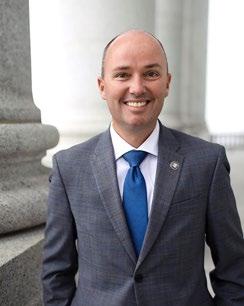 Spencer J. Cox Utah’s 18th Governor
Spencer J. Cox Utah’s 18th Governor

Since the inauguration, I’ve heard from many of you about your hopes and aspirations for the future of our great state. Thank you. My administration is committed to working together as we begin a prosperous 2021.
I’ve also talked with many of you about the challenges we face as we rebound from a difficult 2020. The coronavirus pandemic has ravaged lives and upended livelihoods. Empty storefronts are but one sign of lost dreams, and many in our business community continue to struggle.
Certainly, government has a significant role in nurturing and sustaining local business through these difficult times. So, in the short term, we’re committed to continuing supportive programs launched last year, including:
• Safe In Utah: $5 million for business grants to pay for protective equipment (PPE), cleaning supplies, upgrades to workspaces to keep employees safe, and more.
• Learn & Work In Utah: $16.5 million to provide education and training for the unemployed and underemployed.
• Shop In Utah: $64 million in grants to help local businesses offer discounts to their customers.
You can find information about these grants and much more at business.utah.gov.
In the long term, we’re promoting policies that accelerate Utah’s economic recovery and allow businesses to thrive, from revamping the state’s business incentives programs to simplifying Utah’s tax structure to supporting infrastructure improvements that will bring new opportunities to Utah’s rural areas and throughout the state.
I invite you to send your economic development thoughts and ideas to business@utah.gov. We look forward to working with you and state lawmakers as we innovate, improve and help individuals and businesses live the Utah dream.
Sincerely,
Spencer J. Cox Governor of Utah
BUSINESS.UTAH.GOV | @BUSINESSUTAH 1
Letter from the Executive Director
January 2021
What an exciting time it is to live in Utah. We have a new executive administration, and I have the honor and privilege of leading the state’s economic development charge on behalf of Utah’s 18 th governor, Spencer J. Cox.
When I was asked to serve as executive director of the Utah Governor’s Office of Economic Opportunity (Go Utah), Gov. Cox emphasized how important it is that our work provides economic opportunities to all Utahns, especially those living in rural Utah and other underserved communities.

Of course, we need to focus on Utah’s small businesses, which comprise 99% of all companies and employ 46% of all workers in the state. Utah’s small businesses have taken the brunt of the COVID-19 pandemic. We need to find more ways to support them to maintain an economy that The Wall Street Journal called in December 2019, “America’s economic star.”
Part of supporting Utah’s small businesses has to be a conscious decision by Utahns to buy from and engage with local businesses. You’ll see more from Go Utah on this initiative, launched last year as ‘In Utah,’ in the months ahead.
Another aspect of reinforcing Utah’s dynamic economy is ensuring high consumer confidence. Working with partners, we have initiatives to protect Utahn’s health and support policies to strengthen consumer confidence. A healthy citizenry supports a strong economy, and Go Utah is an advocate for both.
We’re also revisiting Utah’s incentive program, the Economic Development Tax Increment Finance (EDTIF) tax credit. We want to ensure the legislative program is flexible enough for the economy’s ups and downs and works in tandem with state and local strategies for commerce, education, transportation, housing, recreation, and other initiatives.
At its core, EDTIF is the state’s primary tool to support job growth and provide Utahns with economic opportunity. For the past four years, I was involved as a member of the Utah Senate as this office, members of the Legislature and the governor’s office discussed ways to improve the state’s incentive program. Watch for some EDTIF adjustments to be made during the 2021 legislative session.
We’re pleased to say that, since its 2005 inception, two-thirds of EDTIF recipients are local Utah companies, even though the public often believes EDTIF is only used to bring out-of-state businesses to the state. EDTIF helps us support local entrepreneurs and grow Utah businesses.
We’re much more than the EDTIF program. The Go Utah team includes: Business Services to support Utah entrepreneurship Talent Ready Utah for workforce training and development International Trade and Diplomacy Offices of Tourism, Film and Outdoor Recreation
To learn more about our initiatives, please visit business.utah.gov
We will continue to manage programs assigned by the Legislature, and we’ll do it in the most efficient, effective way possible. That’s our charge and duty.
The Go Utah team devotes as much time and energy to the successful pursuit of excellence as any team I’ve encountered. I know this team went above and beyond in its response to the pandemic last year, managing over $170 million in small business support programs. Rest assured, we’ll maintain that level of response and focus to ensure a bright future for Utah businesses and all Utahns.
Although 2021 may be unpredictable, we know Utah’s future is bright.
Sincerely,
 Dan Hemmert Executive Director
danhemmert@utah.gov
Dan Hemmert Executive Director
danhemmert@utah.gov
 Dan Hemmert Executive Director Governor’s Office of
Dan Hemmert Executive Director Governor’s Office of
Economic Opportunity

Contributors
Members of the Go Utah Communications Team assembled the 2021 Business In Utah magazine.
Pete Codella
Pete holds an MBA from the University of Utah and a B.A. in communications from Brigham Young University. He joined the office as director of marketing and communications and a member of the executive leadership team in Aug. 2018 and continues to work in that role. He’s lived in Utah, Texas, New York, Wyoming, Idaho, and Nevada. He likes to work on home projects, cook and bake, and occasionally performs at Hale Centre Theatre in Sandy. Pete and Vickey, his wife of 22 years, live in South Jordan with their two teenage children and aussiedoodle. linkedin.com/in/petecodella | @codella
Tim Haslam
Tim earned a B.S. in communications from the University of Utah and worked in the web development, social media, journalism, and photography fields before joining the office in Feb. 2020. Outside of work, Tim enjoys spending time with his wife and four kids outdoors, watching movies, or building LEGO. It’s not uncommon to find Tim on a lacrosse game’s sideline either coaching, taking pictures, or commentating. Tim and his wife grew up in Salt Lake City and currently live in Farmington.
linkedin.com/in/timhaslam23 @timhaslam
Greg Mytych
A recent transplant to Utah, Greg has been with Go Utah since the beginning of 2020. Hailing from Chicago, Greg got his design degree at the University of Illinois at Chicago. Enamored by Utah’s beauty and outdoor recreation options, he spends his time rock climbing, hiking, and snowboarding. Greg is always looking for his next adventure. linkedin.com/in/gregory-mytych
Amy Steinbrech
Amy holds a B.A. from the University of Utah and a Master of Professional Communication (MPC) from Westminster College. Before joining Go Utah in Dec. 2018, she was a freelance writer and worked as an account manager for a local public relations firm. Amy enjoys exploring Utah’s scenic outdoors. She can often be found hiking in the summer and snowshoeing in the winter. She lives in Sugarhouse with her loyal companion Scout, a five year-old-golden retriever. linkedin.com/in/amysteinbrech @amysteinbrech
Tony Young
Tony started at Go Utah in March 2017 as a communications specialist, where he worked in digital marketing and events. After a few years, he transitioned to the role of media relations manager. Tony earned a Master of Professional Communication (MPC) from Westminster College and a B.S. in community health, with an emphasis in health services administration, from Utah Valley University. He currently resides in Layton with his wife and daughter and has a passion for fly fishing, hunting, snowmobiling, and music. linkedin.com/in/tonythomasyoung
Credits
Business In Utah
An official publication of the Utah Governor’s Office of Economic Opportunity
Editor
Creative Director
Contributing Editor
Staff Writers
Copy Editor
Designer

Pete Codella
Greg Mytych
Amy Steinbrech
Tony Young
Tim Haslam
Frances Johnson
Brian Milne
Go Utah
Executive Director
Deputy Director
Managing Director of Business Services
Managing Director of Operations
Managing Director of Tourism & Film
Director of Compliance
Director of Film
Director of Finance
Director of Marketing & Communications
Director of Outdoor Recreation
Director of Pete Suazo Utah
Athletic Commission
Director of Procurement Technical
Assistance Center
Director of Talent Ready Utah
Director of Utah Industry & Innovation Center
Dan Hemmert
Ben Hart
Ryan Starks
Kori Ann Edwards
Vicki Varela
Jim Grover
Virginia Pearce
Kamron Dalton
Pete Codella
Pitt Grewe
Scott Bowler
Chuck Spence
Kimberlee Carlile
Mary Cardon
BUSINESS.UTAH.GOV | @BUSINESSUTAH 3
About Go Utah
Under Gov. Spencer J. Cox’s direction, the Utah Governor’s Office of Economic Opportunity (Go Utah) provides resources and support for business creation, growth, and recruitment. It also drives increased tourism, film production, outdoor recreation, and mixed martial arts in Utah. Utilizing state resources and private sector contracts, the office administers programs in economic areas that demonstrate the highest potential for development and the most opportunity for Utahns.

Teams include:
Business Services
The Business Services team includes the Office of Rural Development, Procurement Technical Assistance Center, and Utah Industry and Innovation Center. The team supports entrepreneurs and established businesses and reaches every part of the state.
Corporate Recruitment
The Corporate Recruitment team works to help local companies expand, providing jobs and opportunities for Utahns. It also works with the Economic Development Corporation of Utah to help bring new companies and employment opportunities to the state. The team includes the governor’s diplomacy team, the International Trade and Diplomacy group, and Go Utah’s workforce development initiative, Talent Ready Utah.
Office of Tourism
The Utah Office of Tourism acts as the steward of the Utah tourism brand. It engages globally to keep Utah destinations and experiences top of mind while working with Utah communities to support their priorities and promote responsible tourism.
Office of Outdoor Recreation
Established in 2014 as the country’s first outdoor recreation office, the Utah Office of Outdoor Recreation is responsible for driving Utah’s outdoor recreation economy. The team partners with national and local stakeholders to champion Utah’s outdoor recreation and products industries. The office works to ensure Utahns can live a healthy and active lifestyle through outdoor recreation.
Utah Film Commission
The Utah Film Commission was established in 1974 to support the state’s rich legacy of filmmaking. The office markets the entire state as a destination for film, TV, and commercial production by promoting the use of professional local crew and
talent, support services, locations, and state incentives in collaboration with regional stakeholders.
The Film Commission also serves as a liaison to the broader entertainment industry by supporting local film organizations and events, most notably the annual Sundance Film Festival, and facilitating production needs across the state. With thousands of productions created in-state, Utah has an undeniably deep and lasting commitment to the entertainment industry. Utah productions include iconic films such as Butch Cassidy and The Sundance Kid, Thelma & Louise, Easy Rider, and Forrest Gump.
Pete Suazo Utah Athletic Commission
The Pete Suazo Utah Athletic Commission provides a safe, healthy environment for Utah’s combat sports. Mixed martial arts, boxing, and kickboxing are among the events licensed and supported by the Commission.
Operations
The Operations team manages human resources, finances, and compliance. Its team members have decades of state government experience and ensure Go Utah is responsive to legislative requests while managing programs and initiatives in the most efficient, effective way.
Marketing and Communications
The marketing communications team manages all print and digital media for the office, functions as an in-house agency for the office’s other groups, and supports executive leadership with presentation media. The team also produces the governor’s annual Utah Economic Summit and dozens of annual publications, including the Business In Utah magazine.

To learn more, visit business.utah.gov.
BUSINESS IN UTAH | 2021 4
The Utah Governor’s Office of Economic Opportunity Board helps promote and encourage the state’s economic, commercial, financial, industrial, agricultural, and civic welfare.

Go Utah Board



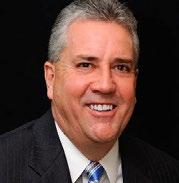



The Go Utah Board consists of 15 members appointed to four-year terms by the governor, with the senate’s advice and consent. No more than eight members are from one political party, and the membership represents all areas of the state.
BUSINESS.UTAH.GOV | @BUSINESSUTAH 5
Brad Bonham CEO Walker Edison
Stefanie H. Bevans CEO & Owner Design to Print
Carine Clark Board Chair & General Partner Pelion Venture Partners
Andrea Moss President & CEO Nelnet Bank
Annette Meier President & COO Superior Drilling Products
Roger Killpack Owner Service Drug
Mel Lavitt Incentives Committee Chair Senior Advisor Needham & Company
BUSINESS.UTAH.GOV

Members




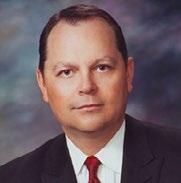



The board advises Go Utah staff on the development, attraction, retention and expansion of businesses, industries, and commerce within the state.
BUSINESS IN UTAH | 2021 6
Ted Wilson
Former Executive Director, UCAIR Former Mayor, Salt Lake City
Jesse Turley Managing Director Bank of America Private Bank
Heather Kahlert Executive Vice President The Kahlert Foundation
Susan Johnson President Futura Industries
Doug Dilley General Manager Commercial Flight Controls Division Parker Aerospace
Margaret Jacobs Member Sundance Utah Leadership Council
Peter Mouskondis President & CEO Nicholas & Co.
Steve Neeleman Founder & Vice Chairman HealthEquity
BUSINESS IN UTAH

Utah’s Economy Amid a Pandemic
Most Utahns only heard casual mentions and a few news reports about a new highly contagious respiratory virus as 2020 started, and the state’s economy was firing on all cylinders. The state had just been named “America’s economic star ” by The Wall Street Journal. In the past decade, it also enjoyed six top-three rankings as the country’s best economy by Forbes, including three times in the No. 1 spot.
Utah’s economy also received top marks from the latest Hachman Index report, identifying Utah as having the country’s most diverse economy. And, 2019 concluded the state’s most successful tax credit program to-date, with 20 companies participating in the legislatively authorized post-performance program. Combined, the companies that received the incentive were projected to create 9,643 high-paying jobs across various sectors, generate $306,196,993 in new state revenue, and fund $602,963,462 in Utah capital investment during the next 15 years.
In a nutshell, Utah’s economy was riding high with low unemployment and favorable economic indicators at nearly every turn.
Then COVID-19 spread across the globe, reaching Utah in March, the same month the World Health Organization declared it a pandemic. The coronavirus pandemic arrived like a road closed sign to the world.
In reaction to the quickly spreading virus, Utah’s governor took a measured approach to closing enterprises and activities to protect public health. Utah’s government, education, and civic leaders gathered and assembled the nation’s first statewide strategic plan to address the pandemic, the Utah Leads Together plan.
While not immune to the pandemic’s impacts, Utah weathered the 2020 storm as well as just about any other state. Like the rest of the country, unemployment spiked in the spring and slowly recovered over time. By the end
of the year, Utah’s leading economic indicators again positioned the state ahead of most other states and very favorably compared to the country. In December 2020, U.S. unemployment was at 6.7%, while Utah experienced just 3.6% unemployment.
It’s difficult to comprehend that a tiny, unseen virus can have such an enormous impact on health and activities worldwide. But, that’s the position we all found ourselves in during 2020.
In response to the coronavirus pandemic, Congress passed the largest stimulus bill in its history, nearly $2 trillion, known as the CARES Act. It provided much-needed relief to Americans and states. Utah received $1.25 billion from the federal government to address the pandemic’s impacts in the state.
BUSINESS.UTAH.GOV | @BUSINESSUTAH 7
OUR COVID-19 RESPONSE
In true collaborative fashion, Utah leaders identified which industries were hardest hit and how to help them. In all, Go Utah managed 11 separate Legislature-allocated programs and initiatives using federal CARES Act funds that infused more than $173,589,765 into the local economy.
Innovative Utah programs included:
Sho p In Utah — A $64 million grant to help support businesses and provide discounts to consumers. Companies that lost revenue due to the pandemic could qualify for grants of up to $150,000 as long as they committed to providing 50% of the grant amount to customers in the form of a discount.
“ I can only think of great things to say about the #ShopInUtah Grant program. The funds allowed us to offer deep discounts on our services. Magpie Cycling sends you a huge thank you.”
— Maggie Wilson, Magpie Cycling
Utah Hospital Grants — $20 million available to Utah hospitals to address their needs resulting from the pandemic.
Learn & Work In Utah — $16.5 million to Utah’s colleges and universities to help workers retrain and re-skill. Participating institutions worked with businesses to create 164 new programs to address unemployment and provide new opportunities. The grant program covered most tuition expenses for Utah students.
“This pandemic forced a great deal of change on all of us in education. One positive result is that it has pushed me out of my comfort zone and caused me to develop the skills necessary to teach in a virtual classroom effectively. Now, I have a great deal more knowledge and ability within my field, which makes me a more effective educator.”
— Tom Carlisle, Parowan, UT
Meet In Utah — $13.5 million to support Utah’s convention and meeting industries.
Small Business Bridge Loan — A $12 million gap funding program to help Utah small businesses with cash flow in early April 2020. Loans were offered at 0% interest and five-year terms with no payments due for 12 months. The Bridge Loan program used state funds, while other programs listed utilized CARES Act funds.
Commercial Rental Assistance
Grant — $20 million to provide rental relief to Utah small businesses that lost revenue due to measures taken during the pandemic to minimize the public’s exposure to COVID-19. The program provided up to $5,000 per month, per location, and up to three months of assistance.
“Thank you very much! These funds come at a time of great need and will go far to buoy my practice during this down period. Please pass along my gratitude to all at Go Utah that are part of this excellent program!”
— Gary Tremayne, OD, Clarity Vision
A Mask for Every Utahn — $11.8 million to distribute 2.3 million free protective, cloth face masks to Utah citizens.
In Utah — A $4.6 million education and outreach initiative that became the state’s umbrella brand for most pandemic economic response efforts.
Live Events Industry Grant — $3 million to support Utah’s live events industry in December 2020.
“Since I received the grant and purchased my new equipment, I’ve hired local sound engineers, recording studios, singers, and musicians and continue to do so weekly. I appreciate everyone who helped provide us with the CARES Act grants. Thank you!
— Shaun Barrowes, Live for Music LLC
Safe In Utah — $3 million to help businesses improve workplace safety for workers and customers during the pandemic through measures such as personal protective equipment (PPE) purchases, workplace redesigns, signage, and technology solutions that allow for distance working.
Utah small businesses were among the hardest-hit segments of the business community. Following the Legislature’s direction, we engineered programs to assist companies with handfuls of employees. In 2020, most supported companies were microbusinesses, with 10 or fewer employees (57%), and 33% of businesses had only one to five employees.
We also established grant criteria, awarding at least 25% of grant funding to rural Utah — including the 25 counties not located along Utah’s Wasatch Front, or every county except Weber, Davis, Salt Lake, and Utah counties. In 2020, 30% of grant funds went to rural recipients.
Among the economically hardesthit industries, 2020 grant funds were distributed as follows:
If there’s one silver lining to the global pandemic, it’s that many valuable lessons for a lifetime were learned. Underscoring Utah’s economic response to the pandemic is an entrepreneurial attitude and collective desire to support Utah’s hard-working residents, upholding the state’s unique quality of life and economic opportunity for all.
MADE POSSIBLE BY
BUSINESS IN UTAH | 2021 8
Healthcare 18% Leisure and hospitality 17% Food and beverage 16% Education 11% Retail 8%
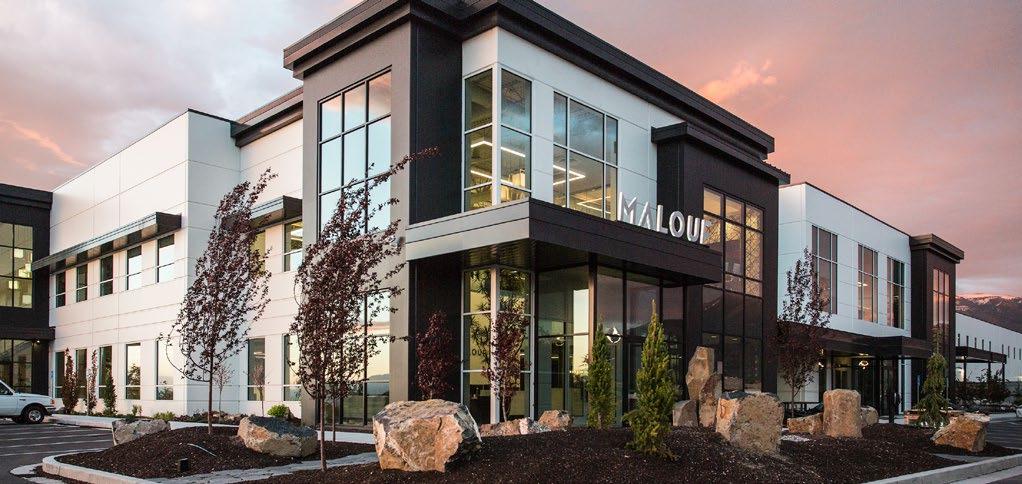
Corporate Recruitment Growth Results in Thousands of Utah Jobs
Highlighting recent corporate expansions
Utah experienced unprecedented economic growth in 2019, with more than 13,000 new jobs created and over $1 billion in new capital invested across 21 new corporate expansion projects. With that momentum from 2019, Utah’s economic development officials had every expectation of surpassing 2019’s performance in 2020.
But COVID–19 had different plans. While 2020 wasn’t the record-breaking year Utah leaders were expecting, the state still saw significant corporate expansions and is positioned for substantial economic growth in the post-pandemic environment.
BUSINESS.UTAH.GOV | @BUSINESSUTAH 9
Malouf
In May of 2020, Malouf announced a $120 million corporate headquarters expansion in Cache Valley for its mattress and bedding business. The expansion will include over 1,195 new high-paying jobs. As an e-commerce company, Malouf’s business continued to grow at exponential rates during the pandemic. They also did their part to support the pandemic response by providing mattresses and bedding to temporary hospitals around the country.
GoHealth
In 2020, everyone became much more aware of the healthcare system and personal healthcare, which is good news for GoHealth. GoHealth’s mission is to improve access to healthcare in America by making the insurance enrollment process easier and less confusing. The company decided to expand its existing Utah operation in May 2020, with plans to add nearly 1,200 jobs to its presence in the Beehive state over the next five years. A new building is set to open Summer of 2022, making Utah GoHealth’s largest location in the U.S.
Misfits Market
Individuals in the western U.S. won’t have to worry about access to fresh, organic, and sustainably sourced produce and pantry staples thanks to Misfits Market’s new distribution facility in Utah, announced in August 2020. Centrally located, with two major interstates intersecting the state and significant rail infrastructure, western U.S. residents won’t need to worry about getting their products from Utah. As the country’s supply chains change, we anticipate other companies will follow Misfits Market’s footsteps and locate their manufacturing and distribution facilities in Utah to access the entire west coast and Midwest in two days or less.
Uniquely Utah
In the new “work from anywhere” environment, professionals from all over the country recognize that Utah’s quality of life and robust teleworking infrastructure create an unbeatable value proposition for professionals and families that enjoy the outdoors.
Many pandemic refugees from crowded and expensive cities already familiar with The Greatest Snow on Earth® experienced Utah’s best-kept secret this year. Utah summers include world-class mountain biking and hiking, socially distant fishing on the world-famous Provo river, or golf at one of Utah’s 120 golf courses, all providing a much-needed change from tiny overpriced apartments and endless Zoom calls. This new migrant workforce provides a significant talent advantage for Utah and local companies looking to tap into that workforce.
Against the odds, 2020 was a successful year for corporate expansion in Utah. As a national leader in economic recovery, and with positive systemic changes coming to the state’s economy, Utah is poised for banner years in 2021, 2022, and well into the future.
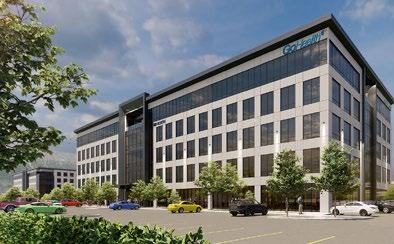
To learn more about Utah’s corporate incentive program — a postperformance state tax credit — visit business.utah.gov and click on Corporate Recruitment & Incentives.

BUSINESS IN UTAH | 2021 10
Utah’s Tourism Industry:
A Force of Nature

In November of 2020, outgoing Gov. Gary Herbert hosted his final virtual roundtable discussion with the Governor’s Office of Economic Development (now-Gov. Spencer Cox’s Office of Economic Opportunity) and his economic development team. The discussion focused on Utah’s travel and tourism industry, with business leaders providing insight into Utah’s tourism industry.
Tourism was among the industries hardest hit by the COVID-19 pandemic, and the discussion acknowledged that the weeks and months ahead held continued uncertainty, but also opportunities and even silver linings. The meeting illuminated the amount of work to be done, but industry leaders endeavored to “never let a good crisis go to waste.”

Strong Foundation
A strong recovery starts with a solid foundation. Fortunately, Utah is built for a robust travel and tourism industry, as Gov. Herbert observed at the November meeting. Indeed, the tourism sector contributes $10.06 billion to the state’s economy annually and supports about 141,500 jobs.
This strong foundation is no accident. Utah’s coordinated and continued investment in tourism put the state on the map as an international travel destination, enabling local communities to build their economy alongside powerful branding such as The Mighty 5®, The Greatest Snow on Earth®, and other targeted campaigns.
Strategy in Motion
The Utah Office of Tourism (UOT) mission is “to elevate life in Utah through responsible tourism stewardship.” According to the statewide plan, achieving this mission takes a balance of proactive marketing, sustainable stewardship, and powerful branding development.
BUSINESS.UTAH.GOV | @BUSINESSUTAH 11

Community-led visitor readiness that attracts quality as well as quantity visitors, and distributed visitation are also critical.
“The Red Emerald business strategy is key to ensuring our efforts contribute to a high quality of life for residents, high-quality experience for visitors and longterm growth in Utah’s tourism industry,” said Vicki Varela, managing director of the Utah Office of Tourism within the Governor’s Office of Economic Opportunity.
The events of 2020 could have derailed this and other tourism strategy and planning. Instead, UOT executed a marketing strategy under Varela’s leadership that appealed to prospective visitors in their current circumstance, matching messages with current travel sentiment. Meanwhile, the state of Utah’s COVID-19 Economic Response Task Force put guidelines in place that enabled the industry to safely open
for business with recommendations to help travelers manage risk and protect Utahns.
The strategy helped Utah outpace neighboring states in its economic recovery and helped hotel bookings rebound faster and higher in several parts of the state. Yet, many businesses were still suffering by the year’s end, especially in convention districts such as Utah’s urban Wasatch Front.
With an eye to the future, the UOT collaborated with Utah’s eight convention districts to make funds available for the Meet in Utah incentive program to attract small group business. The program utilized funding from the CARES Act.
The Utah Legislature acted quickly to pass responsible legislation allocating funds to help Utahns through the pandemic. Legislation provided grants for businesses to manage rent, payroll, and personal protective equipment needs. It also created funds to support the arts and sustain the UOT’s strategic
tourism marketing to help the state secure and hold a competitive advantage.
The future is bright Utah’s landscapes, sustained by its steady cultural heartbeat, will ensure the state continues to attract visitors. New development by counties in collaboration with public land managers and the Office of Outdoor Recreation shows promising growth that benefits communities and visitors alike.
At the Utah Tourism Conference in September of 2020, now-Gov. Spencer Cox summed it up well.
“Our expectations about safe travel have evolved, but we still travel for the same reasons: to get away, to experience something special with our family, and for that soulawakening adventure,” he said. “And that is the vision statement of the Office of Tourism.”
BUSINESS IN UTAH | 2021 12
Utah Film Industry Adapts to Pandemic
 By: Allie Russell
By: Allie Russell
Since the 1920s, Utah has been the backdrop for many memorable Hollywood moments both onscreen and off: John Ford’s West, Butch Cassidy and the Wild Bunch’s stomping grounds, the birthplace of Sundance Institute and the Sundance Film Festival, the end of Thelma & Louise’s journey, and the home of the talented East High Wildcats of High School Musical fame.
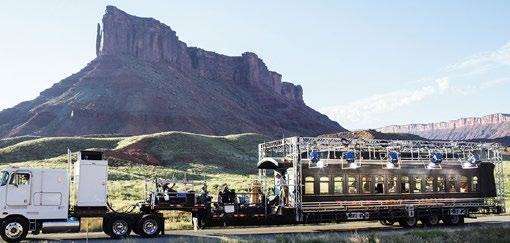
BUSINESS.UTAH.GOV | @BUSINESSUTAH 13
Nine Days (2021), Photo by Wyatt Garfield, Courtesy of Sony Pictures Classics
BUSINESS.UTAH.GOV
Westworld (2016), Courtesy of HBO

Utah’s iconic locations and local industry professionals have helped solidify the state’s place in a competitive film market. While the film industry has always been innovative, 2020 provided an entirely new kind of challenge. As COVID-19 changed every aspect of daily life and business, film in Utah quickly adapted to the “new normal.”
Like most businesses across the country, the film industry shut down in March of 2020 to limit the spread of COVID-19. The Utah Film Commission worked with state, local, and industry task forces to develop recommendations that would allow film productions to get back to work as quickly and safely as possible. New on-set protocols became an essential part of every production, including enforcing face masks, social distancing, and establishing a new department, COVID-19 Compliance.
Once safety precautions were established, small feature productions and commercials were the first to get back to work in May. As of July 2020, 58% of the Utah film industry was back to working about the same or more compared to before the pandemic.
Throughout the summer, out-of-state productions sought out Utah as the perfect filming location because of iconic locations across the state that allowed for social distance and easy accessibility from Los Angeles, eliminating the need for air travel.

Utah continues to grow as a hub for television and feature film production, as evidenced by the 3% increase both in jobs and overall industry annual wages for a total of $147 million in 2019. That same year, 904 film permits were issued across the state, with 54% of them in rural areas.
While shooting on location, feature productions typically contribute approximately $150,000 per day to the local economy. Even in these unprecedented times, film production remains a reliable economic driver that positively impacts the Wasatch Front and rural Utah regions.
The year 2020 saw an increase in both inquiries and productions in Utah, including television series, commercials, and features filmed throughout the state.
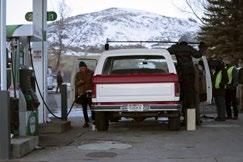
As the Utah film industry continues to adapt to meet new challenges brought on by the pandemic, local crew members and small business owners are working hard to ensure the state’s film industry remains competitive and sustainable. Whatever comes next for the film industry in Utah, one thing is for sure: “We’re all in this together!”
BUSINESS IN UTAH | 2021 14
High School Musical: The Musical: The Series (2019), Courtesy of Disney+
The Wolf of Snow Hollow (2020), Courtesy of Orion Classics
Wireless (2020), Courtesy of Propagate ©
Utah’s Springbar tent company
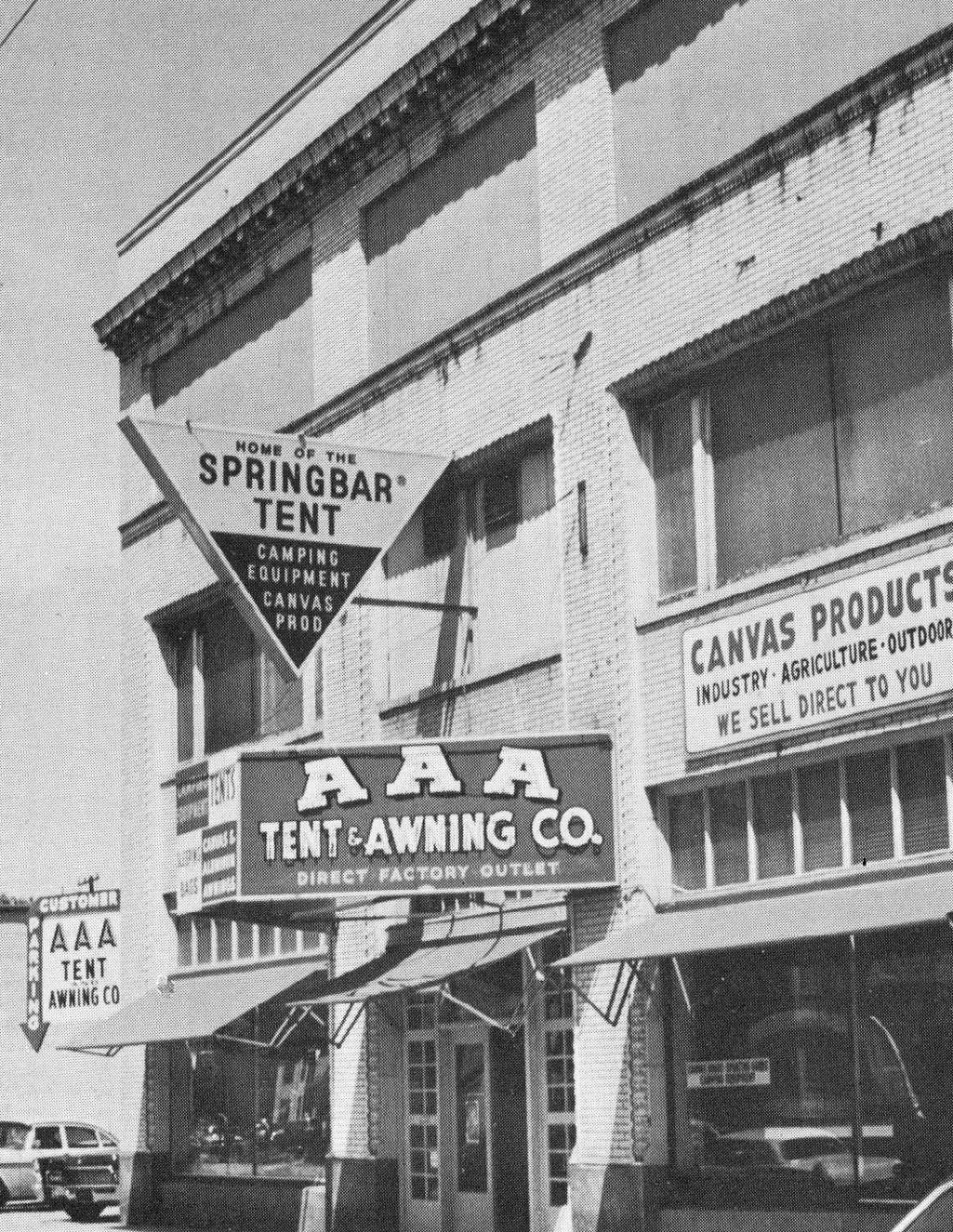
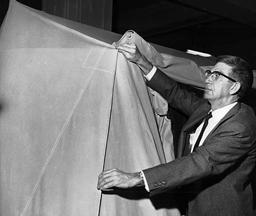
BUSINESS.UTAH.GOV | @BUSINESSUTAH A Tent
Time
As Old As

When you think about camping in Utah, you probably think about sleeping in a Springbar tent. The brand is practically synonymous with outdoor recreation in the state. But the now-global company — built on a foundation of great design and quality — started out small and local. Just like so many good things do.
In 1944, Jack Kirkham Sr. purchased the AAA Tent & Awning shop, which occupied just 1,200 square feet in the heart of Salt Lake City. The shop made canvas goods like tarps, awnings, covers for sheep wagons, and wall tents for outfitters, herders, and miners. As camping became more popular in the 1950s, Kirkham started making more tents for consumers.
But the tent designs of the day didn’t live up to Kirkham’s expectations. Ever the innovator, he went through dozens of prototypes before launching the Springbar tent in 1961. The first 10x10 model retailed for just $83.
After moving to a new shop that included retail space for other camping gear, Kirkham’s Outdoor Products took off, and Springbar tent sales soared. Kirkham’s was the premier place in Utah to get outdoor gear and the most dependable tents. The store carried more than 200 brands, 10,000 items and employed 50 retail sales staff at its peak. In the 1990s, Jack Kirkham Jr., who had been with the company since he was 15, took over operations.
While online competitors have cut into business for mom and pop shops like Kirkham’s, demand for Springbar tents has stayed strong. To keep up with that demand, Jack Jr. partnered with Dwell Outdoors, another Utah outdoor brand that started small and local.
Dwell Outdoors was founded by Pace Measom, a Logan native, and Mike Duncan, who hails from Ephraim. Measom’s dad created their family business, Camp Chef, and built it into a global brand in the outdoor retail space. Duncan has also spent his entire career in the outdoor industry. In addition to founding Dwell Outdoors, Measom and Duncan also created GearDryer, a boot and glove dryer.





“We see ourselves as stewards of a legacy Utah brand. Our goal is to preserve the traditional tent making craft while leveraging modern digital sales and marketing strategies.”
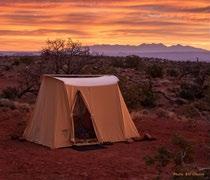
In 2019, Dwell Outdoors acquired the Springbar manufacturing business from Kirkham to bring the brand into the 21st century. So far, efforts include a renewed focus on tent manufacturing, an enhanced digital presence, and a direct to consumer sales and marketing model.
“We see ourselves as stewards of a legacy Utah brand,” said Measom. “Our goal is to preserve the traditional tent making craft while leveraging modern digital sales and marketing strategies.”
One of Dwell Outdoors’ first changes was to create Springbar tent models that could be manufactured overseas. These tents are made from the same canvas and utilize the same design and manufacturing standards that made Springbar tents famous. This hybrid manufacturing strategy made Springbar tents more available to a global audience. The brand now has fan bases in Japan, Korea, and Thailand. It also helped spark more demand stateside.
“As Utahns, we know the story of Springbar tents, and there’s a lot of local nostalgia around it,” said Measom. “But we recognized an opportunity in bringing that story to a much larger audience.”
While Springbar has modernized and evolved, what hasn’t changed is the tradition of USA-made Springbar tents, which are cut and sewn by hand using the same tools and techniques that Jack developed in the early ‘60s. Jack Jr. still oversees the design of the tents.
“We make around 200 USA-made tents a month, and they typically sell out within two hours,” said Measom. “We have employees who have been with the company for 30 years who are still sewing tents and making repairs.”
Some of those repairs are for tents that are more than 40 years old. And the employees working in the shop are as unique as the tents themselves, coming from Afghanistan, Africa, Mexico, Hong Kong, and the Navajo Nation.
In uncertain times, one thing is certain: Springbar tents will be there, keeping you protected from the elements.
BUSINESS.UTAH.GOV | @BUSINESSUTAH 17
 By: Rachelle Ackley
By: Rachelle Ackley
The Talent Ready Utah Center offers programs that support and grow Utah’s workforce in targeted industries statewide. The center brings together representatives from industry, the Utah State Board of Education, the Utah System of Higher Education, the Department of Workforce Services, and the Utah State Legislature to cultivate increased success for the state’s businesses while also enhancing employment opportunities for Utahns.
The center’s flagship program was born out of a workforce development solution deployed for the Boeing Company in 2015. That solution became the Utah Aerospace Pathways (UAP) program. UAP has served as a template for creating additional state pathway programs in industries including life sciences, diesel technology, construction, and aviation technology.
Through these programs, students earn industry-recognized credentials and a guaranteed job interview with partnered employers in high demand, high growth industry sectors through these programs. Statewide pathway programs served over 445 Utah students during 2019. In 2020, the Talent Ready Utah Center partnered with more than 100 employers to provide career exploration, real-time learning and hands-on training to pathway students.
The Talent Ready Utah Center also executes the Strategic Workforce Investment (SWI) program, which was established in 2016. Through this program, education and industry partners can receive funding from the Utah Legislature to create credentialed education pathways driven by
Delivering Innovative Workforce Development Solutions for Utah

“Stadler has been very happy with the progress our apprentices have made in the short time that we have had them.”
BUSINESS IN UTAH | 2021 18

industry-supported work-based learning experiences. In 2019, SWI gave 2,425 students access to multiple on- and off-ramps in their career and educational pathways and employed 768 students.
In 2019, the center added two additional workforce development solutions: the Talent Ready Apprenticeship Connection (TRAC) and the Utah Works program.
TRAC supports apprenticeship programs that engage high school students in hands-on learning. High school seniors split their time between the classroom and workplace, earning an Associate of Applied Science (AAS) degree while working part-time for a participating employer. Stadler Rail first deployed this apprenticeship model in partnership with Salt Lake Community College (SLCC) and the Salt Lake City School District.
“Stadler has been very happy with the progress our apprentices have made in the short time that we have had them,” said Megan Ware, HR lead at Stadler Rail U.S. “Initially,
we thought it would take around six months to see a return on investment from our first cohort of students, but after only six weeks, they were able to perform at the level of a full-time employee. They are incredibly quick to learn and have been great contributors to our team here at Stadler.”
Through the Utah Works program, the Talent Ready Utah Center partners with the Utah System of Higher Education to design pre-employment, short-term training programs that prepare participants to fill in-demand jobs. Between the three partnerships established with Davis Technical College, Ogden Weber Technical College, and SLCC, the Utah Works program has trained and placed 230 individuals in jobs with participating employers.
The Utah Works program also laid the foundation for the recent Learn & Work In Utah initiative, a program requested by the state legislature in response to the workforce impacts of COVID-19. Learn & Work In Utah received federal CARES Act funding for 150 short-term certificate and credit-based training programs that increased access to sustainable employment for displaced workers. To date, 5,456 students have received tuition assistance for Learn & Work programs
in the business, information technology, energy, construction, manufacturing, and healthcare industry sectors.
The heart of the Talent Ready Utah Center is the investment of education and employment partners. Their dedication to preparing Utahns of all ages for a sustainable and fulfilling professional future drives the center and its workforce development programs. As the center seeks innovative ways to solve current and new workforce challenges, it will continue to bolster Utah’s economy, creating stable, prosperous opportunities for Utah families and individuals.
BUSINESS.UTAH.GOV | @BUSINESSUTAH 19
Building Bridges Between Business and Education
Learn about the Wasatch Centers for Advanced Professional Studies (CAPS) program
Most high school juniors and seniors are suffering through chemistry and calculus, and dreaming of graduation. But high school students in the Centers for Advanced Professional Studies (CAPS) program are designing facades for their local community centers, raising chukars and releasing them into the wild, redesigning websites for local businesses, and so much more.

Through CAPS, students in the Davis, Duchesne County, Nebo, Provo City, Park City, and Wasatch school districts work with local businesses and industry mentors to develop professional skills while still in high school. The program builds connections between local companies and students to help prepare the next generation of employees. Communication, problem-solving, productivity, collaboration, social skills, and creativity are just a few of the targeted skills the program hopes students will develop.
“We found that local businesses struggled to find recent college graduates who had professional skills,” said Wasatch CAPS Director Weston Broadbent. “These recent graduates were smart and welleducated, but struggled when it came to something as simple as writing a clear, concise email or having basic problem-solving skills.”
Courses offered through CAPS vary by location. Through the Wasatch CAPS program in Heber City, for example, Wasatch High School students can take classes in business, marketing, entrepreneurship, engineering and industrial design, medicine and health, digital design and software development, environment, and agriculture. Industry partners who are part of the CAPS program agree to assign students projects that meet real business needs, require research and diligence, and have an end goal or deliverable tied to a business outcome. Students work in groups of two or three per project and, in many cases, students cross-collaborate between courses to gain exposure in a variety of areas of study.
Students work on high-level projects that expose them to aspects of management and leadership. Some of the current projects at Wasatch CAPS include creating a new marketing campaign for the Zermatt Utah Resort in Midway, analyzing different summer amenities for the Utah Olympic Legacy Foundation at Soldier Hollow, learning the value and power of digital
marketing by creating search engine optimization (SEO) and content for a website startup, and creating patient experience videos for Intermountain Healthcare.
Students say they love the CAPS program, and for some, like Erik Figueroa, the experience is life-changing.
“I wasn’t going to classes. I was sluffing a lot,” said Figueroa. “My parents never finished high school, and I’m the oldest of my siblings, and I wanted them to be proud of me. CAPS provided the opportunities I was interested in and helped shape my future.”
Figueroa had a 2.1 GPA before joining CAPS with no plans for the future. Through CAPS, he worked with Alpine Development on a townhome project in Heber City. Figueroa and his classmates were in charge of land surveys and a logo and name for the project. The experience made Figueroa feel energized and excited about school. He was a leader at CAPS and helped his team with several challenging problems. The experience left a lasting effect on his life. Figueroa is now working to save money for college.
Businesses that work with CAPS programs can be involved in education in a meaningful way. The CAPS students, in turn, are trained and prepared to be better employees. CAPS is one of Utah’s important bridges between business and education.



BUSINESS IN UTAH | 2021 20
STRATA Connects Communities
By: STRATA Networks
Justin Hansen describes growing up in the Uintah Basin, riding four-wheelers and snowmobiling with his dad, like living in a Norman Rockwell painting. But he also grew up with a passion for information technology and computers.
“I was the 12-year-old kid taking WordPerfect classes instead of playing baseball or football,” he said.
Hansen graduated in 1996 and left his hometown to pursue his dream job because there were very few local technology jobs available.


Many Americans, including Hansen, share the dream of living wherever they want while still having access to the rest of the world. That dream is one of the reasons STRATA Networks was founded as a cooperative over 65 years ago. STRATA’s commitment to connecting communities is still prevalent in everything it does today.
Based in Roosevelt, Utah, STRATA is a forward-thinking telecommunications company, continually expanding services and technology for its customers, like Justin Hansen, who want to live and work in remote areas without sacrificing a career they love.
After living in a large city, Hansen hoped to return and raise his family in the idyllic setting he experienced as a kid. Fiber-optic internet from STRATA made that possible.
“If it weren’t for the availability of gig fiber that I have to my house, moving back to the Basin wouldn’t have even been a choice,” Hansen said.
Recognizing that many people like Hansen would come back to the Uintah Basin if the workforce infrastructure they needed was there, Vernal City and Uintah County built an innovative coworking space leveraging STRATA’s fiber network. STRATA committed to providing the gigabit internet connection for the facility so that new doors will open for other residents like Hansen who want to come home.
BUSINESS.UTAH.GOV | @BUSINESSUTAH 21
Due to the rugged landscape and rural setting of the Uintah Basin, infrastructure costs pose significant financial barriers to delivering service to these areas. STRATA worked diligently to secure additional funding to bring internet services to even its most remote customers and received a $23.6 million loan-grant combination from the U.S. Department of Agriculture ReConnect Program.
These funds will help STRATA build the necessary infrastructure to deliver fiber internet to more than 3,000 of the most remote households, farms, businesses, and critical community facilities spread over 400 square miles in Duchesne and Uintah Counties. STRATA already has nearly 10,000 fiber locations with a goal to build more than 1,000 additional locations each year.
Continuing its commitment to bring service to the most remote parts of the region, STRATA partnered with the Utah Education & Telehealth Network (UETN), the Utah Department of Transportation (UDOT), and Daggett School District to complete an extensive 68-mile fiber-optic project to connect schools and health clinics within Daggett County. With roughly 40% of the route in rocky or solid rock conditions, this project was a massive, two-year engineering feat.
“Access to high-speed internet has transformed from being a convenience to a necessity — especially in education and healthcare,” said STRATA Networks CEO and general manager Bruce Todd. “We are proud of the partnership that STRATA and UETN have formed to make fiber internet accessible to even the most remote areas in our region, and we look forward to seeing the community and economic development that will come from it.”
STRATA’s commitment to keeping the community connected was more evident than ever when schools and businesses were closed due to COVID-19. During this time, STRATA pledged free internet to all new customers who had a student or educator in their home.
They also offered free speed upgrades for current customers where possible and established several free community WiFi hotspots. STRATA waived late fees and pledged not to terminate any customer because of their inability to pay due to the pandemic, and provided internet access to students who qualified for the CARES Act through local school district grant funding.
“Utah leads the nation in internet availability with some of the best broadband speeds in our rural counties,” said Rebecca Dilg, rural outreach manager at the Governor’s Office of Economic Opportunity. “The work STRATA does to bring broadband to rural Utah is representative of our many Utah broadband providers.”
The Governor’s Office of Economic Opportunity works with broadband providers, policymakers, consumers, community institutions, and other stakeholders to support broadband deployment throughout the state, improve efficiencies, and expand statewide access and adoption.

BUSINESS IN UTAH | 2021 22

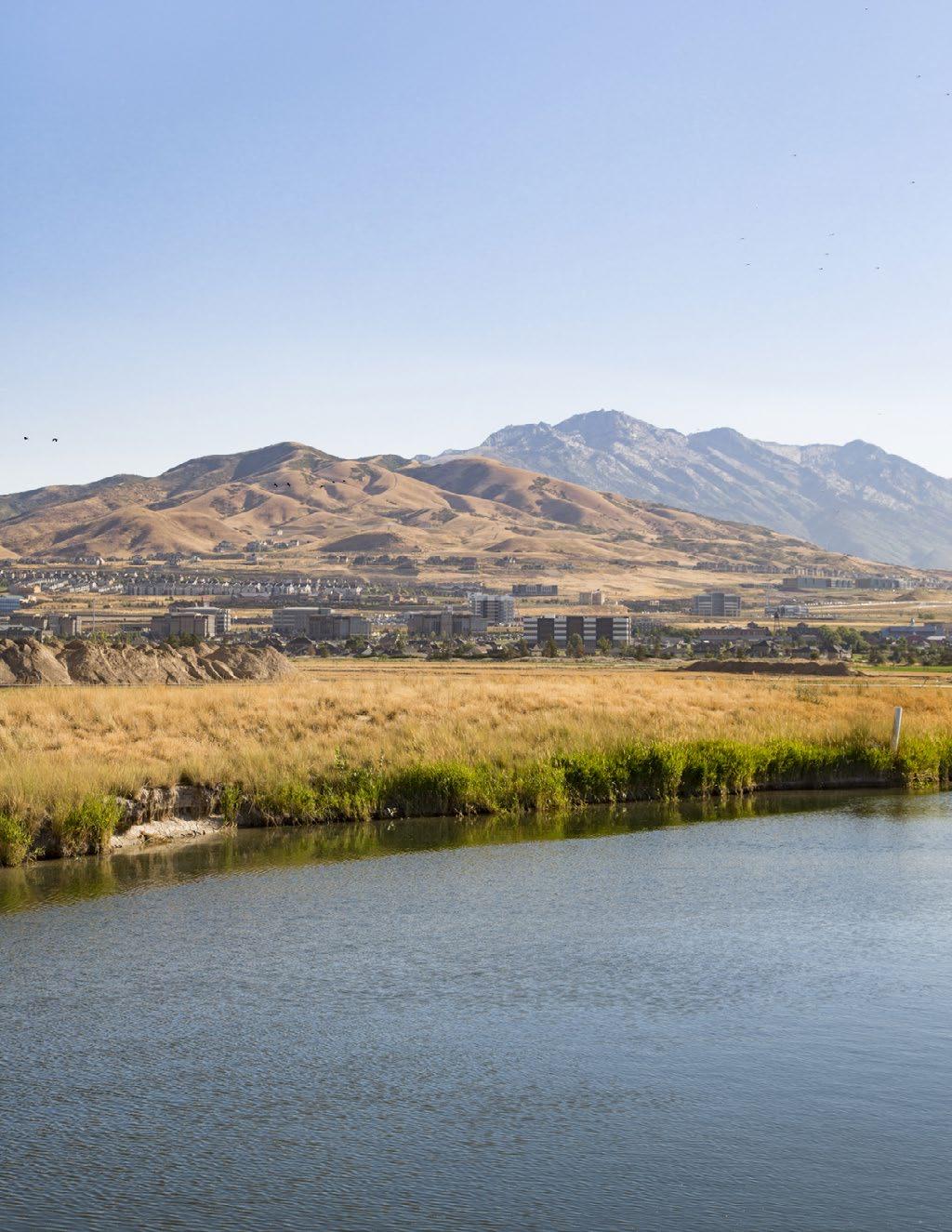
What’s The Point?
Utah’s Once-in-a-Lifetime Opportunity
What do you do when 600 acres of land becomes available in the heart of a world-class technology hub? In Utah, you develop it into a sustainable and innovative community that will attract new businesses and residents for years to come. That’s exactly what’s happening now in an area of Draper known as The Point.
The 600 acres currently house the 70-year-old Utah State Prison. When the prison was built, Draper was considered a rural part of Salt Lake County with less than 4,000 people. By 2020, Draper had close to 50,000 residents and was also home to several large businesses. Pluralsight, for example, just relocated its headquarters to a new 350,000-square-foot building in the nearby foothills.
UTAH OPPORTUNITIES
BUSINESS.UTAH.GOV | @BUSINESSUTAH

To make way for more economic development and bring the prison into the 21st Century, the Utah State Prison will relocate to the Salt Lake Valley’s far northwest corner in mid-2022. And that means the sky’s the limit for development at The Point.
The Point is part of a larger strategic development area called the Point of the Mountain, which covers 20,000 acres and spans several cities and two counties. In 2016, the Utah Legislature appointed 18 people, known as the Point of the Mountain Development Commission, to oversee the larger site’s development. The commission enlisted Envision Utah to help create a complete and comprehensive vision for the area, taking into account transportation, air quality, job growth, housing, open spaces, and recreation areas. The commission also worked with local governments, existing employers in the area like eBay and Adobe, transportation agencies, economic development groups, landowners, and educational institutions.
The vision was released in 2018 and includes a vast array of signature elements, including:
• A diverse and highly-trained workforce
• Improved air quality and reduced natural resource use
• Vibrant urban centers; and
• Jobs close to where people live
This vision will help shape further development at The Point.
“We are committed to making The Point a sustainable innovation community and an accessible destination for everyone,” said Alan Matheson, The Point executive director, who was hired in 2019 to oversee development of the 600 acres. “We have a duty to make prudent decisions that will directly benefit current and future generations of Utahns. We intend to plan and develop The Point in a way that facilitates mobility, creates economic opportunity, improves air quality, and ultimately enhances our quality of life.”
Along with Matheson, an 11-member board, known as The Point of the Mountain State Land Authority, guides The Point’s development. The board has assembled five working groups composed of public and private sector subject matter experts who are providing advice and technical expertise. As the board moves forward with developing a master plan, it is soliciting robust input from the public, especially since some recommendations made
by the commission and the board will be up to cities and counties to implement on their own.
Utah has long been known as the Crossroads of the West, and the Point of the Mountain now has the potential to transform the state into the Crossroads of the World with The Point at the very center.
“There is nothing quite like The Point anywhere else in the world,” said Matheson. “Utahns have a unique, once-in-a-lifetime opportunity to create a sustainable, future-focused development of national and global importance.”
The Kem C. Gardner Institute at the University of Utah projects the Point of the Mountain region will attract up to 150,000 higherpaying jobs in the next 30 years. Sales and personal income tax revenues generated from the area are estimated to range between $12 billion to $19.7 billion, not including corporate taxes or revenue from outside the area.
As a framework for the site emerges, the potential is truly skyhigh, and a world-class community is beginning to take shape right in the heart of Utah.
BUSINESS IN UTAH | 2021 24
UTAH OPPORTUNITIES
 By: Utah Inland Port Authority
By: Utah Inland Port Authority
Utah Inland Port Authority:
Why Utah, Why Now?
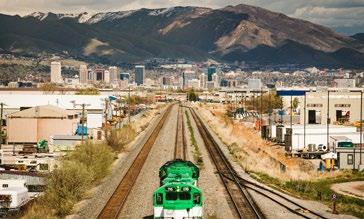

A third of Utah’s Gross Domestic Product is dependent on the logistics industry — and, fueled by consumer demand, that number is expected to grow. But as we witnessed in 2020, an unknown shock to the supply chain can disrupt the balance of our global logistics network and our daily lives.
The Utah Inland Port Authority (UIPA) supports the logistics systems that make up the economy’s backbone. That means using Utah’s geographic advantages and optimizing the rail, road, and air infrastructure in place to make cargo movement more efficient and sustainable for generations to come.
UTAH OPPORTUNITIES BUSINESS.UTAH.GOV | @BUSINESSUTAH
Utah’s unique position in the supply chain includes direct connections to three major global ports in California, which serve as the international gateways for nearly 80% of Utah’s import and export value by sea. Those goods funnel throughout Utah, which is why the Port Authority has a mandate to establish and oversee a statewide network.
Up until now, the logistics industry in Utah has been left to grow locally and organically. Having an organization to plan and oversee all the state’s logistics network components maximizes the economic benefit and asserts the public will while also mitigating community and environmental impacts.
“Utah’s inland port is not a place, it’s a system — and a system for all of Utah,” said Jack Hedge, executive director of the UIPA. “Strengthening that system connects Utah businesses to the global market in a more cost-effective way and helps prepare their assets, workforce, and operations for the future.”
UIPA’s focus on cargo flows and how truck and rail goods are moved is pivotal to increasing utilization and expanding access for commerce throughout the state. UIPA is working to identify what regional logistics assets are already available, which will help inform the creation of satellite ports. Those ports will form a network that integrates and connects to major distribution points around the United States. This network will bring more family-wage jobs and smart logistics infrastructure, next-generation sustainable technology, industry, and trade opportunities to rural Utah and the state.
“There’s a misperception that having a port only adds traffic, development, and pollution. But logistics is changing rapidly, and the market is demanding a move to more sustainable practices,” Hedge said. “UIPA’s role is often not about adding more, it’s about being smarter. We no longer have to build dirty logistics. You inherit them; you don’t have to rebuild them.”
The UIPA has the unique opportunity to create the first logistics hub in the country to incorporate policies, standards, and incentives that drive technology and innovation in emissions and air quality. Current UIPA agreements with Rocky Mountain Power, Dominion Energy, and AVF Energy will help develop renewable energy generation projects, including solar, hydrogen fuels, and renewable natural gas. UIPA is actively engaged with state and municipal agencies, monitoring air and water quality to establish baseline levels and create master plans for the current jurisdictional area in northwest Salt Lake County. Using tax differential funding, UIPA can promote sustainable building practices and upgrades to company fleets.
Being at the forefront of technological advancement will be critical for the state’s position in global logistics going forward. Utah already has a fiber optic backbone built-in as part of the state’s enviable infrastructure, which can be used to revolutionize how logistics are done. UIPA provides the expertise for research and development of smart technology with logistics applications. Those innovative possibilities, Hedge says, make Utah’s inland port the most significant impact opportunity the state has had in decades.
“I took this position because it’s one of a kind, and we all have a chance to be a part of something unique and exciting — where Utah is leading the way,” Hedge said.
Logistics Fast Facts
Every 100 rail cars take 300 truck trips off the road, reducing greenhouse gas emissions by an average of 75%
Cargo movements in Utah are expected to double in value by 2045
36% of Utah’s GDP comes from logistics-dependent industries
647,000 Utah jobs are in logistics-dependent industries
$26 billion in Utah earnings come from logistics-dependent industries
80% of Utah’s international containers come through California
BUSINESS IN UTAH | 2021 26
UTAH OPPORTUNITIES





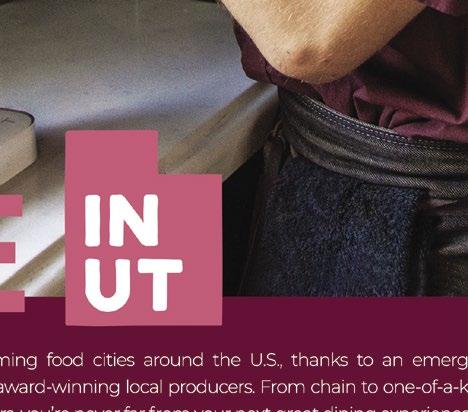

Targeted Growth Through Collaboration: Utah’s Opportunity Zones and Mega Sites
Utah is known for cutting-edge universities, a booming tech scene and robust life sciences industry, national and state parks, and world-class outdoor recreation. But you might not know that Utah is also home to 46 Opportunity Zones and numerous Mega Sites. These economic growth outlets provide investors with opportunities to generate lasting community impact while earning market or above-market rate returns on investment.
Stimulating growth in underserved and overlooked communities
In partnership with the Utah Association of Counties and the Sorenson Impact Center, the Governor’s Office of Economic Opportunity has prioritized education, outreach and engagement on the opportunity zone incentive in rural communities throughout the state. Opportunity Zones are a new community development program established by Congress in the Tax Cut and Jobs Act of 2017 to encourage long-term investments in low-income and urban communities nationwide.
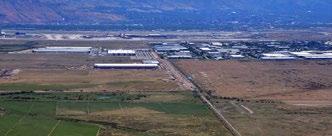
In Utah, this community initiative evolved into the recently announced Rural Opportunity Zone and Recovery Playbook, a new two-year program jointly funded by Go Utah and the Economic Development Administration (EDA).
“The goal of the playbook is to share rural economic development best practices and provide technical support to projects in 21 participating counties,” said Grant Baskerville, director at the Sorenson Impact Center. “Over the next two years, we will seek to support a more equitable recovery from the COVID-19 pandemic, drive investment into an array of impactful developments, and support economic diversification.”
For more information about the program, visit opportunityzones. utah.gov.
Bringing new investment to Utah
Attracting new manufacturing projects to the state requires a daunting amount of research to identify operation sites. How do growth-minded communities balance the need for data with the need for speed? Luckily for Utah, a program exists to help.
In 2018, under Go Utah’s direction, the Economic Development Corporation of Utah (EDCUtah) launched the Utah Mega Sites program.
Mega Sites are large-acreage land sites that are extensively vetted and pre-qualified through the Utah
Mega Sites certification process to house large and complex corporate projects.
According to Katherine Morrell, who directs the Utah Mega Site program for EDCUtah, certification is “a detailed process involving geotechnical analysis, engineering studies, utility availability studies, land use and planning studies, air quality and environmental studies, and a lot of due diligence. It’s really in-depth.”
The state now boasts 11 different Mega Sites, ranging from the 610acre Northwest Quadrant site in Salt Lake City managed by the Colmena Group to the 418-acre Iron Springs Mega Site west of Cedar City. These Mega Sites have plenty of advantages for prospective clients.
“Take a head-to-head comparison of two similar parcels, one certified and one not. The certified parcel has an advantage in that questions about the site’s characteristics and viability are all answered,” Morrell said. “A project’s timeline is more predictable and is faster to market.”
For more information about the program, visit edcutah.org/siteselection/utah-mega-sites-program.
BUSINESS IN UTAH | 2021 28
UTAH OPPORTUNITIES

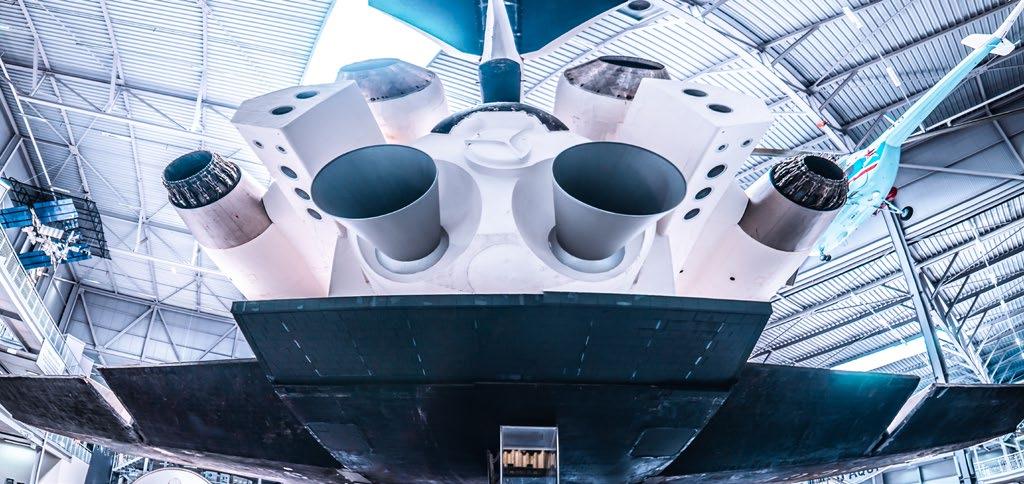
Utah’s Entrepreneurial Spirit Is at the Core of Its Advanced Manufacturing Companies
Using innovation to advance technology and products isn’t anything new to Utah. The state’s advanced manufacturing industry includes more than 150 cutting-edge companies dedicated to expanding the advanced materials, manufacturing, technology development, and design sectors.
BUSINESS.UTAH.GOV | @BUSINESSUTAH 29
TARGETED INDUSTRIES
Utah’s Newest Targeted Industry Sector
Over a decade ago, Utah began a cluster initiative to emphasize key sectors with economic development opportunities.
“After a thorough analysis, we decided to elevate advanced manufacturing as our newest industry sector,” said Ryan Starks, managing director of Business Services at the Governor’s Office of Economic Opportunity. “There is a strong manufacturing sector in Utah, and this diverse sector includes many state-of-the-art companies doing amazing work.”
A recent report from the Kem C. Gardner Policy Institute showed that Utah’s manufacturing industry accounts for 7% of the state’s total employment and almost 10% of overall earnings. And while manufacturing is slowing in other parts of the country, Utah’s manufacturing industry continues to grow.
Advanced manufacturing continues to be relevant across various industries, including outdoor recreation, aerospace, defense, structures, and medical devices.
In 2018, the total economic impacts of Utah’s manufacturing industry, both indirect and induced, included 427,980 jobs and $26.4 billion in earnings. Overall, manufacturing supports one-fifth of all Utah jobs and one-quarter of Utah’s total gross domestic product (GDP) and earnings.
Utah Success Story
Utah company, ENVE Composites, went from a struggling business to a premier consumer-focused enterprise thanks to a new emphasis on passion-based performance for customers and employees. Previously a researchoriented company, ENVE is now known for its manufacturing of premium cycling carbon wheels and components.
Once ENVE’s executive team determined it was best to manufacture its products in the United States rather than off-shore, ENVE never looked back.
“It was the best decision we made. We had an uncompromising belief that we could do it,” said the company’s CEO, Sarah Lehman.
In 2016, the company was acquired by Amer Sports and now operates as a subsidiary, bringing more jobs and capital investment to the state.
Early Innovation
Utah companies Hercules and Thiokol Chemical both made their mark on the state by innovating manufacturing processes.
Hercules started supplying dynamite to the mining industry in the early 1900s, eventually producing all the U.S. Armed Services’ rocket propellant in World War II. Its work on solid propellants in the 1950s scored Hercules the chance to lead development of the third-stage engine for for Minuteman missile. In 1960, Hercules was awarded a $50 million contract to produce an improved second-stage solid-fuel rocket motor for the Polaris A-2 Fleet Ballistic missile.
The company continued to work with NASA to provide retrorockets for the Ranger moon shot program. Hexcel Corp. purchased the company’s composite product division in 1996, but Hercules’ innovation legacy remains.
Thiokol Chemical started producing synthetic rubber and polymer sealants in 1929, becoming a significant supplier in World War II. Moving on to work with propulsion systems, the company built-out its rocket test range in Utah to support a contract to test Minuteman missiles. Through several acquisitions, including Morton Thiokol and ATK-Thiokol, the company most recently became part of Northrop Grumman, continuing its substantial presence in Utah.
Adding advanced manufacturing to Utah’s targeted industries is more than fitting for a sector that has been an essential part of Utah’s economic growth for decades.

BUSINESS IN UTAH | 2021 30
TARGETED INDUSTRIES

Growth and Expansion Continues for Utah’s Aerospace and Defense Companies
Like its mountain landscapes, Utah’s aerospace and defense industry is deep and wide. Businesses including Boeing, Northrop Grumman, L3 Harris, Parker Hannifin, and Hexcel are among the nearly 1,000 aerospace and defense companies with a decades-long history of producing, selling, and servicing commercial aircraft in Utah.
BUSINESS.UTAH.GOV | @BUSINESSUTAH 31
TARGETED INDUSTRIES

The state’s robust aerospace and defense ecosystem — which employs close to 34,000 people — was selected in 2020 as one of six Defense Manufacturing Communities in the nation to receive funding through the Defense Manufacturing Community Support Program (DMCSP), managed by the U.S. Department of Defense.
The DMCSP provides $5 million over five years to help expand successful aerospace industry programs while also funding new initiatives to help communities prepare for the future of defense manufacturing. The ultimate goal is to create a single integrated program, including a prepared workforce, robust supply chain, cutting-edge research, small business support, and innovation incubators.
The DMCSP will be managed by the Utah Governor’s Office of Economic Opportunity (Go Utah), which leads the Utah Defense Manufacturing Community. Go Utah will partner with the Utah Advanced Materials and Manufacturing Initiative (UAMMI) to administer the programs.
“The DMCSP elevates Utah to the next level as a destination for aerospace and defense companies and brings innovative ideas to reality,” said Dr. Tulinda Larsen, UAMMI executive director. “We could not be more optimistic about the future of this ecosystem.”
Much of the aerospace and defense ecosystem’s strength in Utah is linked to Hill Air Force Base (Hill AFB), the state’s sixth-largest employer. Hill AFB, home to the Air Force Materiel Command’s Ogden Air Logistics Complex, served as the Minuteman Missile logistical center and is now part of the Air Force Sustainment Center.
BUSINESS IN UTAH | 2021 32
TARGETED INDUSTRIES

Led by Colonel Jenise M. Carroll, Hill AFB is the worldwide manager for a wide range of aircraft, engines, missiles, software, avionics, and accessories components. In addition to cutting-edge programs, it hosts high-tech military testing at Dugway Proving Grounds and several other developments at the Utah Unmanned Aerial Systems test center.
Private aerospace and defense companies also thrive in the state. Two of them — Northrop Grumman and L3 Harris — recently announced plans to expand in Utah. Northrop Grumman Corporation — currently the largest security and defense company in Utah with more than 5,100 employees — plans to create up to 2,250 new jobs in the next 20 years. The company provides innovative systems, products, and solutions in autonomous systems, cyber, space, strike, and logistics and modernization to customers worldwide.
L3 Harris established roots in Utah in the 1950s and will add up to 250 jobs and $6.7 million in new state revenue over the next eight years. As a Top 10 defense contractor, L3 Harris plays a critical role in designing and manufacturing products to protect and defend freedoms worldwide.
Preparing and providing a talented workforce for these companies is key to the aerospace industry’s success across the state. Utah’s eight degree-granting colleges and universities offer robust programs to support and train aerospace engineers, materials scientists, and business experts. Specialized programs provided through technical colleges provide specific training and certifications to fill machinist, welder, and composite technician talent pipelines.
In 2015, aerospace and education leaders in the state formed an unprecedented partnership to develop the aerospace talent pipeline further. Together they created an industry-recognized certification that high school students could earn in one year. The certificate includes
an internship and coursework, culminating in a guaranteed job interview with participating companies. Now known as Utah Aerospace Pathways (UAP), the program served 100 Utah students in 2020 alone.
“UAP provides a clear career path beginning with high school students and adult learners alike,” said Kimberlee Carlile, director of Talent Ready Utah. “Participants can not only see their future but shape it, by getting into a career with upward mobility and ultimately building a strong and capable workforce for the state’s aerospace industry.”
As Utah’s aerospace and defense industry sector builds on past accomplishments to create a prosperous future, the sky is truly the limit.
BUSINESS.UTAH.GOV | @BUSINESSUTAH 33 TARGETED INDUSTRIES

Giving Utah Small Businesses and Entrepreneurs a Competitive Advantage
The Utah Industry and Innovation Center, an office within the Governor’s Office of Economic Opportunity (Go Utah), works with companies, industry partners, and collaborators statewide to build and strengthen businesses and the state’s innovation ecosystem. The Center focuses on targeted industry sectors and assists companies in their Small Business Innovation Research (SBIR) and Small Business Technology Transfer (STTR) pursuits.
A Collaborative Effort
Through collaborations with the Small Business Development Centers (SBDC), which offer expertise to those interested in starting and growing a business, and the Procurement Technical Assistance Centers (PTAC), which help companies with the federal procurement process, the Innovation Center helps companies access resources to develop their business and commercial pathways. Both the SBDC and PTAC have offices across the state, each with region-specific knowledge.
“The work the Center does allows Utah innovators’ dreams to come to fruition,” said Ryan Starks, Go Utah’s managing director of Business Services. “Their pledge to help clients every step of the way is truly amazing and demonstrates their commitment to excellence.”
BUSINESS IN UTAH | 2021 34
TARGETED INDUSTRIES
Other targeted partners include the Suazo Business Center, Women Tech Council, Womenpreneurs, and Women’s Business Center of Utah, providing expertise for minority and women-owned businesses. Additionally, local Chambers of Commerce encourage companies to share their experiences and mentor business owners to reach for the next goal.
Universities located throughout Utah also collaborate with businesses regularly. Southern Utah University hosts a Small Business Development Center with a full range of services. Both Utah State University and the University of Utah support technology transfer from their institutions. For example, the University of Utah is launching a new accelerator, Altitude Labs, open to any life science company. Utah boasts nearly two dozen accelerators statewide, each offering space and mentoring for new business owners.
Working closely with sector-specific organizations, including BioUtah and Silicon Slopes, the Center assures cohesive messaging and inclusion. There is a robust community of Angel Funds and Family Offices supporting Series A funding in Utah, each supporting companies in their equity funding pursuits. The state is also home to VentureCapital.org, one of the country’s oldest venture capital firms.
The Center also works closely with state organizations, such as World Trade Center Utah, to support companies interested in pursuing international markets.
Non-Equity Position Funding
The Utah Industry and Innovation Center offers a wide range of support services to Utah companies interested in the federal SBIR and STTR programs. Referred to as America’s Seed Fund, these programs offer $4 billion annually in competitive non-equity position dollars to move innovation forward and into the marketplace.
The Center helped bring over $44 million from these programs to 53 Utah companies in seven counties, many of which are now thriving. The Center boasts a win rate nearly twice the national average and received national recognition for its work, winning the Small Business Administration 2016 Tibbetts Award.
Utah business owners also recognize and appreciate the work of the Utah Industry and Innovation Center.
Tom Wolf, CEO of Silicon Technologies Inc. (STI), started his company in 2009 with two staff members and an idea. After winning SBIR funding in 2011, STI has grown to become a key player in electronic components and circuits resistant to damage or malfunction caused by high levels of radiation, referred to as Rad Hard Technology.
“The Center staff taught us how to submit the best proposals. We know how to create new ideas, but are not good with following instructions, and I attribute our success directly to their expertise,” said Wolf.
“The Air Force now believes in our technology and selected STI to host their annual Radiation Hardened Electronics conference in Salt Lake City. We will bring together hundreds of Department of Defense program managers to see firsthand how Utah is upending the chip industry from our Midvale, Utah headquarters. It would not have been possible without the Utah Industry and Innovation Center. Period.”
Companies from across all industries utilize the Center’s assistance throughout the state, running their research and development through the SBIR program exclusively. The technology innovations run the spectrum from interstellar antennas to apps, 4D X-ray to testing dust accumulation in space, pharmaceuticals and medical devices, cancer detection, and more.
“We are in awe of the technology put forth by Utah companies, where there is no lack of innovation or talent,” said Mary Cardon, director of the Utah Industry and Innovation Center. “Our job is to make certain the companies present not just the innovation, but the team that will carry the project, the market need, and the path to get there. Utah’s companies do not disappoint at any level.”
BUSINESS.UTAH.GOV | @BUSINESSUTAH 35 TARGETED INDUSTRIES
Utah
Green Energy Hub of the West

Millard County is home to what could become the West’s new energy hub, thanks to a reconfiguration of the state’s largest coal-fired power plant.
By 2025, the Intermountain Generation Station in Millard will be decommissioned as a coalfueled power plant. New natural gas-fueled generating units will come online with green hydrogen as part of the fuel mix. Initially, 30% of the overall energy output will come from green hydrogen, expanding to 100% by 2045 as technology evolves.
“Many coal communities around the country are struggling with the closure of power plants,” said John Ward, spokesman for the Intermountain Power Agency, the owner of the entire project, known as the Intermountain Power Project (IPP). “IPA, and the other project participants, have diligently worked to develop new energy projects
that can build on the substantial infrastructure already in place at IPP, including land, regional transmission systems, rail, highway, and a highly-skilled energy workforce.”
Green hydrogen is made using machines called electrolyzers, which have been around for centuries. During a process known as electrolysis, water is broken into hydrogen and oxygen. The oxygen is released into the atmosphere, and the hydrogen is captured. As long as the electricity to power the machines comes from a renewable source such as wind or solar, the process results in zero greenhouse gases, unlike other forms of hydrogen production that release carbon dioxide into the air.

BUSINESS IN UTAH | 2021 36
TARGETED INDUSTRIES

Hydrogen is widely used in refining and chemical manufacturing and is playing a growing role in transportation. Now, the proliferation of solar and wind energy are making green hydrogen viable. At times, energy from these sources exceeds the demand for them, making them financially attractive options to power electrolysis. More and more hydrogen power applications are created each year, from buses to airplanes to forklifts, further increasing demand.
As part of the Millard plant’s reconfiguration, Mitsubishi Power Americas will install turbine generators to create electricity from natural gas and hydrogen. However, not all the hydrogen generated will be used immediately, so it will need to be stored until it’s ready for use.
A potential storage solution is a geological structure known as salt domes. Huge underground caverns created through solution mining provide an economical way of storing hydrogen for use even months later.
Coincidentally, the largest and only commercial salt dome in the western United States is underneath the Millard generation station. Magnum Development owns the salt dome. Mitsubishi partnered with them to create an advanced clean energy storage project that will produce and store large quantities of green hydrogen immediately adjacent to IPP. The facility has the potential to be one of the largest renewable energy storage reservoirs in the world.
“This is a unique and important opportunity for Utah,” said Laura Nelson, executive director of the Green Hydrogen Coalition and co-organizer of the Western Green Hydrogen Initiative. “The state will be engaged in building the energy hub of the West while providing more jobs to rural communities, all while generating clean energy.”
With the reconfiguration of the generation station, the potential use of the unique salt dome structure, and the development of clean energy storage, Utah is poised to help other states and cities achieve the reality of clean energy. For example, Eric Garcetti, mayor of Los Angeles, announced in 2018 that L.A. has committed to net-zero carbon emissions by 2050. The Los Angeles Department of Water and Power will use power from the IPP to help achieve that goal.
BUSINESS.UTAH.GOV | @BUSINESSUTAH 37
TARGETED INDUSTRIES

When it Comes to Banking, Utah takes Center Stage
As Utah’s largest and fastest-growing key industry, the financial services sector plays an essential role in the state’s robust economy. The industry includes commercial and industrial banks, credit unions, fintech, insurance enterprises, and other financial service businesses.
BUSINESS IN UTAH | 2021 38
TARGETED INDUSTRIES
“Utah is already at the forefront of innovation in financial services. We welcome new ideas, collaboration, and partnerships — they thrive here,” said Howard Headlee, president of the Utah Bankers Association.
Utah is one of the nation’s top states for financial services employment, with an employee base of over 84,000 people. The industry has realized significant employment growth over the past several years, and the trend is expected to continue. According to JobsEQ, the Salt Lake City metropolitan area saw a 10-year historical growth rate of 30% with a four-year projected growth rate of 6%.
Utah and National Financial Policy
From early on, Utah has had a profound effect on national monetary and banking policy. Utah’s own Marriner S. Eccles served as Chairman of the Federal Reserve under President Franklin D. Roosevelt and advocated for long-term financial solutions and protections, including federal insurance for banks, a centralized Federal Reserve System, tax reforms, a minimum wage, and governmental regulation of the stock market. Eccles influenced how the government can use
money to control the economy. He argued for deficit spending during the Great Depression and pushed for a balanced budget during World War II.
Fintech and Industrial Banks
One pinnacle of Utah’s strength in the financial services sector is the industrial bank segment, which has been part of the state’s economy for 110 years. Today, Utah is the nationwide center for this banking sector.
In March 2020, two new industrial banks, Nelnet Bank and Square Inc., received approval from the Federal Deposit Insurance Corporation (FDIC) and state of Utah, and were granted industrial bank charters. They are the first newly chartered industrial banks in over a decade.
Nelnet Bank launched in early November, providing student loan refinancing with plans to offer students private loan options.
“We’re excited to help students and families meet their education goals by providing lending products that are innovative and customerfocused,” said Andrea Moss, Nelnet Bank CEO. “Being the first industrial-chartered bank established since 2008 provides us the ability to serve the changing needs of the higher education market.”
Square Financial Services is expected to launch in 2021 and will act as a subsidiary of Square Inc., a financial services and mobile payment company based in San Francisco, Calif.
According to a Kem C. Gardner Policy Institute report, at year-end 2019, Utah-chartered industrial banks held $140.6 billion in assets, representing 93.5% of total assets held by industrial banks in the United States. The state’s industrial banks funded $1 billion in loans, investments, and donations to support lower-income communities in Utah and other states, especially with affordable housing.
Growing Banking Industry
Utah is also home to 10 prominent banks that left the industrial bank sector between 2004 and 2018, and now operate under commercial bank charters. These former industrial banks further boost the economy and provide more than 4,600 jobs and $315 million in employee and self-employment earnings.
By combining history with innovation, Utah continues to leave its mark on the financial services industry.
BUSINESS.UTAH.GOV | @BUSINESSUTAH 39 TARGETED INDUSTRIES
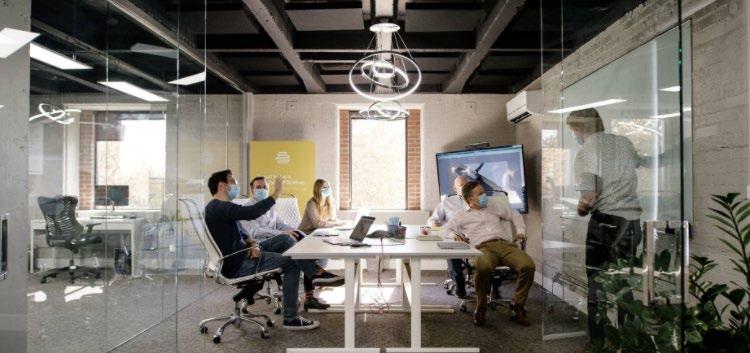
Life Sciences
Collectively known as BioHive, Utah’s thriving life sciences and healthcare innovation ecosystem has been the fastest-growing life sciences community in the United States since 2012. BioHive comprises 1,100 Utah companies and employs 130,000 Utahns who develop, manufacture and distribute the pharmaceuticals and medical devices that make modern healthcare possible worldwide.

BUSINESS IN UTAH | 2021 40
TARGETED INDUSTRIES
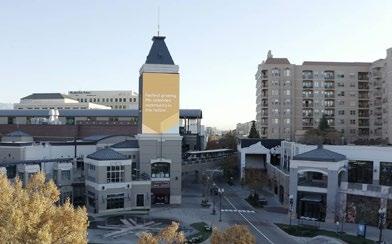
Utah is a hub for medical innovation
Katelin Roberts, interim director of BioHive, named several reasons life scientists flock to Utah.
“First of all, we have world-class companies headquartered here,” she said.
International life sciences companies such as BioFire, Merit Medical, and Myriad Genetics began in Utah.
“We have a huge community, and the halo effect around life sciences accelerates companies that support their efforts as well,” Roberts added.
Utah is fifth in the nation for diagnostics development, sixth for medical device development, the epicenter for life-saving catheter technologies, the world leader in genetic research, and a rising force in bio-pharma. Utah has one of the largest life sciences hubs per capita in the nation, and together, Utah life sciences companies generate $9.6 billion in sales annually.
BioHive attracted $4.1 billion in investment from 2013 to 2017, including venture capital, subsequent rounds of funding, mergers and acquisitions, and public stock offerings. As the life sciences industry expands, more inputs are required from suppliers, creating additional jobs and investment opportunities in other
parts of the state’s economy. The industry has a significant impact that many in Utah appreciate, including state lawmakers.
“We have a supportive government,” said Roberts, naming Gov. Spencer Cox, a Republican, and Salt Lake City Mayor Erin Mendenhall, a Democrat, as examples of BioHive’s bipartisan support.
Local companies respond to COVID-19
A collaborative community that values diversity, BioHive has a strong trade association, BioUtah, and a wealth of public-private initiatives. These partnerships proved invaluable when Utah life science companies, health care providers, and local governments joined forces to address the coronavirus pandemic.
While other industries suffered during the pandemic, BioHive remained a strong economic force. Roberts describes it as “recessionproof.”
“There is a huge spotlight on healthcare right now during the COVID-19 crisis and a recognition of the industry and how important life science is to Utah,” said Roberts. “The life science industry in Utah creates opportunities for jobs and saves patients’ lives.”
Amid the 2020 pandemic, the Utah drug discovery company Recursion and the University of Utah’s Center for Technology & Venture Commercialization founded Altitude Lab, an incubator and accelerator for early-stage life science companies. The lab provides a space where life science entrepreneurs can access a cutting-edge 14,500-square-foot facility equipped with nearly $1 million worth of the latest molecular and cell biology tools.
Other collaborative laboratory spaces in Utah include BioInnovations Gateway, which provides laboratory space for start-up companies and workforce development for students through the Granite School District, and Utah Nanofab, a premier multidisciplinary nanotechnology laboratory at the University of Utah that is expanding the frontiers of nanotechnology research.
Knowledgeable workforce and lifestyle advantage
Even before students enter universities, Talent Ready Utah’s Medical Innovations Pathway program offers specialized courses and practical work experience for high school students to help them develop skills to qualify for careers with Utah’s most elite medical device and laboratory testing companies. The program is executed under the leadership of BioUtah and its industry partners.
“We have 12 major colleges and universities and the youngest median age in the country, which means you get a young and very talented workforce here in Utah,” added Roberts.
There are also lifestyle advantages that draw a talented pool of potential hires to Utah.
“Utah’s a fantastic place to live, and we all love it,” said Roberts. “We have an industry that pays 50% higher than Utah’s average wage, and you can still get to the mountains or the desert, depending on where you are, in about 30 minutes. Utah’s seen a lot of growth in the last decade, and we’re wellpositioned for even more future growth.”
BUSINESS.UTAH.GOV | @BUSINESSUTAH 41 TARGETED INDUSTRIES
Utah’s Science Guy
Breaking through barriers and taking Utah with him
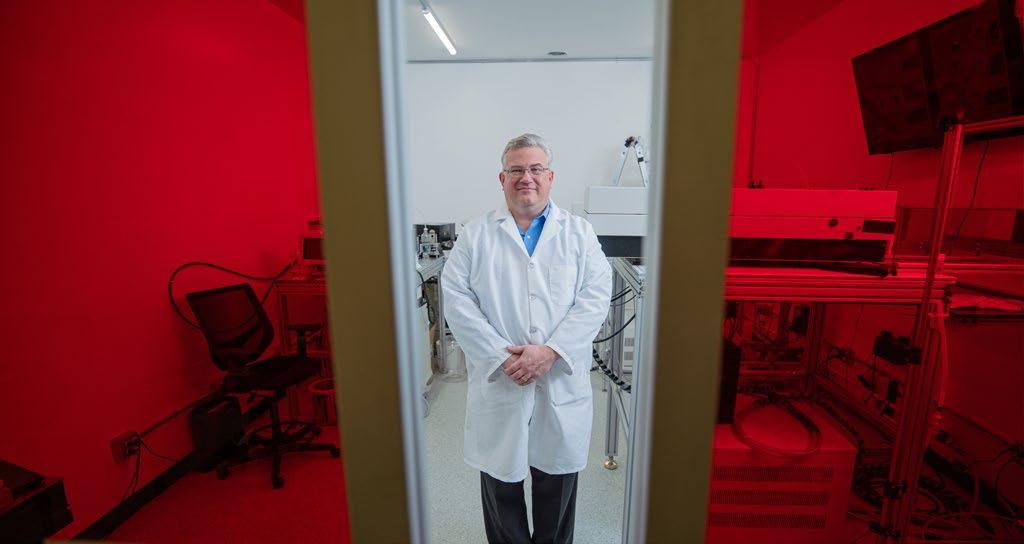
Utah’s closest thing to the popular Bill Nye the Science Guy is physicist and inventor Bill Niedermeyer. Niedermeyer thinks everyone can be a scientist — and he’ll stop mid-task to make sure you’re following him as he explains every detail with unrivaled enthusiasm.
An expert marksman and gourmand, Niedermeyer is unassuming and friendly. Now, partnered with a team of world-class scientists at EVÕQ Nano, he is leading Utah to the future of nanotech.
This branch of technology cuts across numerous scientific disciplines — physics, chemistry, microbiology, engineering, just for starters. Nanotechnology came on the scene decades ago with big promises and mind-blowing models.
It’s taken that long for the actual science to catch up with theory.
Niedermeyer, EVÕQ Nano’s chief technology officer, and Dr. Bretni Kennon, Ph.D., chief science officer, spent hundreds of hours at the University of Utah’s Nanofab doing science no one else is doing and

BUSINESS IN UTAH | 2021 42
TARGETED INDUSTRIES
painstakingly capturing and documenting imaging of their uniquely spherical, non-ionic particles.
In animated tones, Niedermeyer and Kennon report about their latest “field trip” to the university.
“We can see exactly where our materials are in the bacterial cell. We permeated the membrane without lysing (rupturing) it,” Kennon explains. “And we can see our materials evenly distributed throughout the dead bacteria.”

Nanomaterial is the smallest of the small. A nanometer is one-billionth of a meter, about half the width of a DNA chain. The customengineered particles Niedermeyer and Kennon test in EVÕQ Nano’s North Salt Lake City labs are between four and 10 nanometers.
At that size, material stops behaving as expected on the macroscale. Solids become liquid, opaque becomes transparent, stable turns combustible, and knowns become unknown.
Further, most nanomaterials are ionic and can be dangerous to humans or the environment. But data indicate EVÕQ Nano’s material is safe, earth-friendly, and effective.

EVÕQ Nano CEO Scott Morrison focuses on translating key findings into viable market solutions.
“We feel a deep responsibility to harness this technology’s potential. We dialed in the manufacturing and research, and we are seeing incredible results.” he said.
The company’s latest win includes killing antibioticresistant superbugs. Partnered with the National Cystic Fibrosis Foundation (CFF), EVÕQ Nano and Seattle Children’s Hospital found key ingredient EVQ-218 demonstrated in vitro efficacy against more than 60 different strains of bacteria and fungi, including many of the world’s worst pathogens.
Project advisor Thomas Hofmann, MD, Ph.D., wrote:
“[EVQ-218] has been shown to have broad and consistent antiinfective potential against lung pathogens in [cystic fibrosis], from the common pathogens (P.a., Staph, Stenotrophomonas) to the more rare and difficult pathogens (fungi, NTM, Burkholderia). Therefore, it qualifies as an excellent, broadspectrum candidate for inhaled drug development.”
Rafael Hernandez, MD, Ph.D., Center for Global Infectious Disease Research at Seattle Children’s, agreed EVQ-218 indicates “promise as an anti-infective therapy for [cystic fibrosis].”
With this data, EVÕQ Bio, EVÕQ Nano’s biotech and pharmaceutical division, initiated a Food and Drug Administration path for EVQ218 and is completing toxicology studies, with its FDA pre-IND meeting near.
Meanwhile, EVÕQ Energy is developing lead-acid battery prototypes with reputable battery manufacturers to penetrate the home energy storage market, and EVÕQ licensing deals provide vital ingredients to create antimicrobial textiles and surfaces.
The project has come a long way since the early 2000s when Niedermeyer trolled technology conferences to share small bottles on his high energy-ablated nanoparticles, evenly suspended in Rocky Mountain water.
Back then he didn’t know exactly what he had. Nearly 20 years later, Niedermeyer knows his nanoparticles are truly unique— unlike any other nano. And he’s more confident than ever that the nanotech frontier is endless.
Learn more at evoqnano.com.
BUSINESS.UTAH.GOV | @BUSINESSUTAH 43
TARGETED INDUSTRIES

Opportunities Abound in Utah’s Software and Information Technology Arenas
Thanks to companies like Adobe, Ancestry, Domo, Micron, Qualtrics, Pluralsight, and many others, Utah is one of the nation’s top states for information technology employment. The state consistently ranks high on the list of fastest-growing states for tech jobs.
In 2019, Utah tech jobs grew by 4.6%. Tech companies supported one in seven Utah jobs and represented one-sixth of worker earnings, generating over $2.5 billion in tax revenue annually. In addition to 118,600 Utah jobs in the tech industry itself, tech-related firms provided 50,100 jobs in related industries.
Another 43,800 Utah employees worked in technology occupations for non-tech companies. The state has high concentrations of software developers, web developers, computer and information research scientists, and many other IT-related professions.
BUSINESS IN UTAH | 2021 44
TARGETED INDUSTRIES
Growing Silicon Slopes Impact
Silicon Slopes, a nonprofit formed over a decade ago, connects members of Utah’s growing tech sector. In 2019, Silicon Slopes joined forces with the Utah Technology Council to empower Utah’s tech community.
“We’ve seen remarkable growth in the tech industry here in Utah,” said Clint Betts, Silicon Slopes executive director. “Entrepreneurs are focused on providing opportunities for their employees as well as providing needed solutions that can have a local and global impact.”
For example, Utah tech industry partners stepped up to provide wraparound funding through the Silicon Slopes Computer Science Fund at the Community Foundation of Utah to help ensure every child has the opportunity to learn critical computer science skills needed to unlock their full potential.
This effort supports the state’s desire to fund computer science education for every Utah student from kindergarten through high school. Collaboration between industry, government, and education leaders helped align similar efforts through a statewide plan.
Opportunities to Grow Throughout the State
Salt Lake and Utah counties provide most of Utah’s tech jobs, but the industry creates economic opportunity throughout the state. Homegrown and transplant tech innovators leverage decades of private and public investments in Utah’s tech sector.
With one of the nation’s strongest economies, Utah continues to experience low unemployment across all strategic sectors despite the COVID-19 pandemic. Over the next five years, the most significant labor force needs are likely to be software application developers, computer and information systems managers, computer user support specialists, and systems software developers.
“Providing Utah students with the skills they need to thrive is critically important, and it starts with enabling our teachers who are the key to increasing computer science learning opportunities for students,” said Aaron Skonnard, co-founder and CEO of Pluralsight.
Pluralsight, Inc. entered into a multi-year partnership with the Utah State Board of Education to advance K-12 computer science training through its social enterprise, Pluralsight One. The partnership will support teacher and staff training that ensures computer science education will be an essential part of school curriculums across the state.

Women in Tech
The Women Tech Council’s growing influence spotlights the importance of inclusivity in the technology sector.
“With more than 13 years of creating scalable programs from high school to the boardroom, we have seen an incredible impact in changing the career trajectories of thousands of women,” said Cydni Tetro, president of Women Tech Council. “By uniting leaders and companies across the tech industry, we’ve activated more than 17,000 girls into STEM fields through internships, mentoring, opportunities and inspiration to expand the talent pipeline and help close the gender gap in tech.”
With Silicon Slopes leading the charge, all of Utah is onboard to support the tech industry and its continual growth.
BUSINESS.UTAH.GOV | @BUSINESSUTAH 45 TARGETED INDUSTRIES

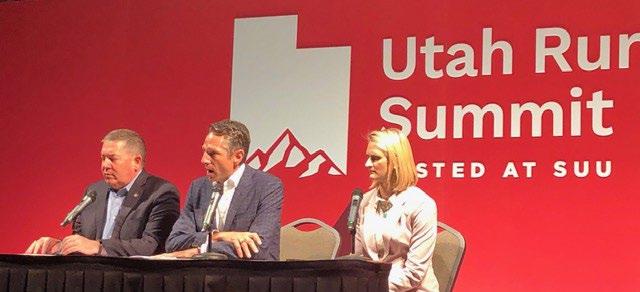
Rural Workforce Network
Brings Economic Development Opportunities to Rural Utah
In 2018, Salt Lake Chamber president and CEO, Derek Miller, issued a challenge to the Chamber membership, especially company CEOs: look at your workforce and see if there are opportunities for employees to work remotely in rural Utah.
BUSINESS IN UTAH | 2021 46
RURAL UTAH

“We don’t need to go far to do our work on this and to make a difference,” Miller said at the time.
At the time of his address, initiatives were already underway on the government side to develop remote workforce opportunities — an effort initiated by then-Lt. Gov. Spencer Cox., the Department of Workforce Services Director Jon Pierpont, and his staff. They were among the first to identify several hundred jobs that could be done just about anywhere in Utah.
Recognizing a critical inflection point, the Salt Lake Chamber and the Department of Workforce Services joined forces to move the rural workforce initiative forward. It didn’t take long to realize that they needed the help of another rural development partner, EDCUtah. In 2019, at the Rural Summit in Cedar City, the three entities signed a memorandum of understanding formalizing the Rural Workforce Network.
As the group continued to do its work, it added more partners. Today, the Rural Workforce Network team includes: The Salt Lake Chamber, Department of Workforce Services, EDCUtah, Go Utah’s Office of Rural Development, and USU Rural Online Initiative. This unique team brings together all the state resources and brain-trust to help employers and job seekers connect anywhere in the state.
When the pandemic hit in early 2020 — intensifying the need for viable remote work options across Utah — the team was well established and moved towards implementing a rural jobs website (see: slchamber.com/ rural-workforce-network).
During much of 2020, the Rural Workforce Network team worked remotely themselves — recruiting and training private companies throughout Utah to encourage them to post their remote job opportunities on jobs.utah.gov using the hashtag #ruraljobs
To date, the team’s work includes:
• 4 virtual webinars
• 25+ companies trained
• 19 employers posting remote jobs on the #ruraljobs website
• 151 remote jobs available for rural job seekers
COVID-19 raised the awareness, opportunity, and value-add of remote work. Thanks to significant investments made years ago in broadband and distance education delivery, Utah is well-positioned to expand the remote workforce, and efforts to expand the rural remote workforce are just beginning.
If you are working to create, find or advertise jobs that can be done anywhere in Utah, the Rural Workforce Network Team is here to help. Please reach out to David Busk for more information at dbusk@utah.gov.
Help us grow #ruraljobs and bring economic mobility and prosperity to rural Utah.
BUSINESS.UTAH.GOV | @BUSINESSUTAH 47 RURAL UTAH
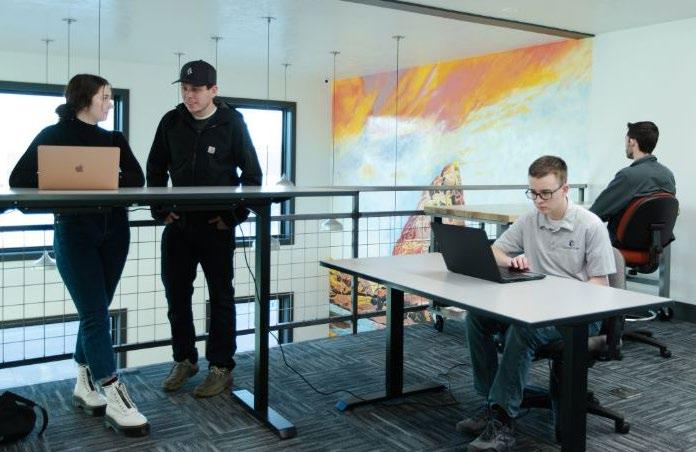

A Place for Remote Work in Rural Utah
Grant funds available
As Utah’s population continues to grow and technology allows employees to work remotely, living in rural areas is becoming increasingly attractive. To encourage people to move to and stay in rural Utah while also enhancing the experience of working in a rural setting, the Utah Legislature created the Rural Coworking and Innovation Center grant.
RURAL UTAH
Qualifying entities for this grant include counties, cities, higher education institutions, and private companies within a defined county outside of the Wasatch Front and Washington county. The grant helps these entities design and build facilities that provide the infrastructure and equipment individuals in designated rural areas need to participate in the online workforce. Each application is vetted by a committee that determines eligibility and grant awards.
Officials in rural Utah are hoping the grant will help reverse the trend of rural residents moving to the Wasatch Front for college, getting jobs, and never returning.
“We want our kids to come home,” said Callie Ward, an assistant professor who oversees the Center at the Utah State University Extension in Panguitch. “In order to do that, they have to have a place to work where they can access high-speed internet and equipment, and the feeling of ‘going to work.’”
The Center in Panguitch, which will open in April 2021, is housed in an old middle school. When a new middle school was constructed, the city renovated the building and moved the library and city office there. Now, through the RCIC grant, they have added a coworking space and a commercial kitchen. The Center hopes to attract workers who are developing software programs, running an eCommerce business, or who provide technical support and entrepreneurship. The commercial kitchen will allow food entrepreneurs to provide goods for local markets and restaurants.
In Escalante, the Utah State University Extension received a grant and is designing a space that is three times as large as the Panguitch Center. It will have more private offices.
Both Centers will offer one-time access for residents and others who need to send an important email or join a virtual meeting.


The Southeastern Utah Business and Technical Assistance Center, located in Price, was awarded two grants for two Center construction phases. Phase 1 of the project created an ADA-compliant coworking lounge, barand-stool desk space for up to eight people, privacy booths, a large meeting space, and a smaller conference room. Phase 2, set to be completed this year, will upgrade the HVAC system and add a 3D printer and virtual reality equipment. Michael Bryant, who oversees the Center, is hopeful the 3D printer and VR equipment will help spark innovation in residents, including high school students.
“They can design a product at their house or in school then come print it at our Center,” said Bryant. “The Center has really helped our residents, and we’re proud to contribute to their success.”
The Price Center opened in September 2020 and has 13 individual businesses within its walls, including therapists, home health and hospice, insurance agents, and a trucking company.
In total, nine RCIC locations in rural Utah are currently in operation or under construction.
RURAL UTAH

Iron County Shines
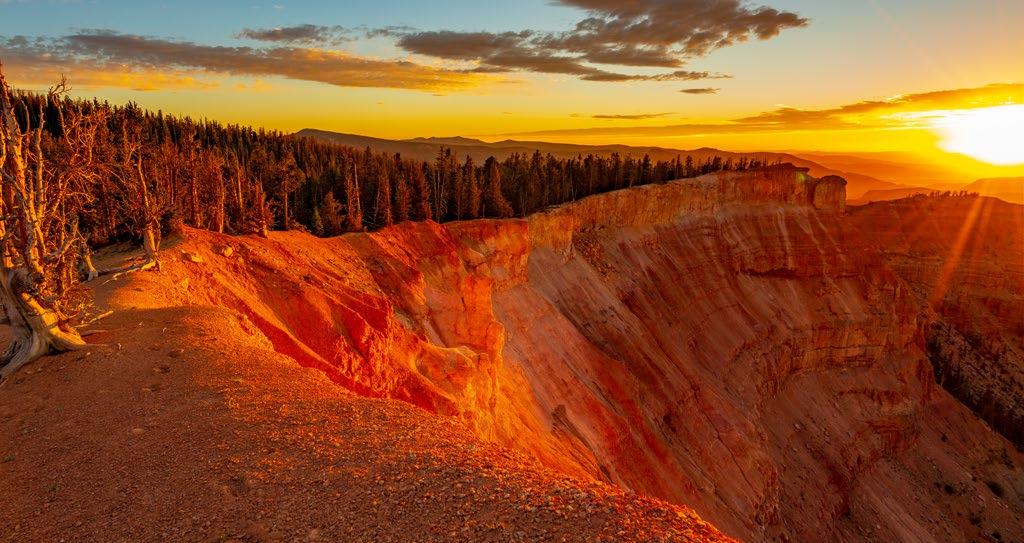
Despite all the turmoil associated with the global COVID-19 pandemic, Cedar City wrapped up 2020 with some bright economic indicators moving into the New Year.
While the county’s tourism industry took a severe hit with the shut-down of the Utah Shakespeare Festival and the Larry H. Miller Utah Summer Games, other sectors of Cedar City and Iron County’s diverse economy surged. The year saw strong population growth, record-breaking enrollment at Southern Utah University, high new job growth, and recordshattering residential construction.
Iron County joined Washington, Tooele, and Utah counties as one of the four fastest-growing
counties in the state from 2019 to 2020 with a 2.67% countywide increase in population. The Cedar City area was ranked fourth nationally in annual percentage growth. By far, SUU’s enrollment growth was the highest among Utah’s public universities in a year when half of Utah’s public colleges and universities saw a decrease in enrollment.
Iron County followed the state and the rest of the country. with job losses early in the year. However, unlike most areas, the county showed employment growth of 1.3% (year over year). According to the Utah Department of Workforce Services, Iron County was one of only four Utah counties showing job gains in 2020.


REGIONAL SPOTLIGHT
BUSINESS IN UTAH | 2021


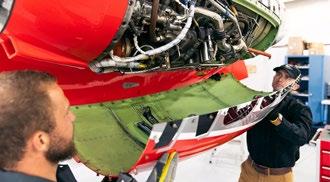
Leisure/hospitality services experienced the county’s largest job losses, with professional/business services and information sectors also showing declines. In contrast, manufacturing, construction, healthcare/social services, and retail trade displayed increased employment levels.
Pandemic unemployment peaked in Iron County at 9.3% in April, lower than both the state and national averages. By September, the county’s jobless rate had ebbed to 5.2%, which is still much higher than in the months preceding COVID-19. The loss of so many jobs in the leisure and hospitality industry and the addition of higher-paying manufacturing and construction jobs increased the county’s average wage by 11%.
In Iron County, homebuilding seems to have ignored the pandemic, with dwelling unit permits up 55% over 2019. Cedar City surpassed 2019’s total of 591 building permits in September and continued strong through the end of the year. By the end of December, Cedar City had issued 819 permits.
The year-to-year gross taxable sales in Cedar City were up significantly in 2020 with a 20% increase over the previous year, compared to the state’s 6.4% increase. Some of this is due to online sales, but motor vehicle sales and general merchandise stores performed exceptionally well.
Cedar City’s transportation assets, including rail, interstate highway, and a regional airport, continue to play an essential role in the area’s economy. Cedar City is within easy reach of every major market in the Western United States. Los Angeles, Phoenix, Denver, Las Vegas, and Salt Lake City are all less than a day’s truck drive away.
REGIONAL SPOTLIGHT BUSINESS.UTAH.GOV | @BUSINESSUTAH

These assets are a significant reason Iron County is considered a potential satellite location for the Utah Inland Port Authority. The area’s transportation assets contribute to the success of numerous manufacturers that utilize rail service, interstate highways, and air service.
GOEX Manufacturing has begun construction on its new 118,000 squarefoot facility, and Realine Steel is completing construction on 90,000 square feet of new manufacturing space in Cedar City. These companies are bringing more full-time, high-paying jobs to the community.
Continued growth and expansion of other large manufacturers, including Charlotte Pipe and Genpak, is increasing the number of primary employment jobs in Cedar City.
In addition to transportation infrastructure, SC Broadband is investing heavily in Cedar City’s high-speed internet infrastructure. Beginning last January, the company started a project to deliver gig-speed fiber to every neighborhood in the community with affordable rates. As more people found themselves working remotely in 2020, this infrastructure make Cedar City increasingly more appealing.
In the past few years, Cedar City’s south Main Street has seen the addition of several new businesses, including a new State Bank of Southern Utah branch, Courtyard by Marriott and LaQuinta hotels, a Maverik, and more. Superior Development has started work on a new 19-acre mixed-use project in the area, to include new residential and business opportunities.
Overall, Cedar City businesses are anticipating a strong 2021.




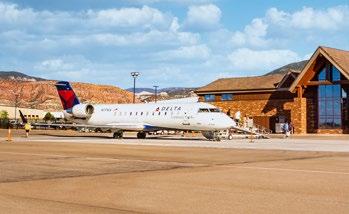
BUSINESS IN UTAH | 2021 52
REGIONAL SPOTLIGHT
Cache Valley
Economic Success at the Top of the State
With an impressive 2.8% unemployment rate, currently the lowest in the state, Cache County has held strong during the COVID-19 pandemic. CNBC recently praised Logan City for having one of the lowest unemployment rates in the country at 2.4%, noting that it has maintained a “bulletproof job market.”
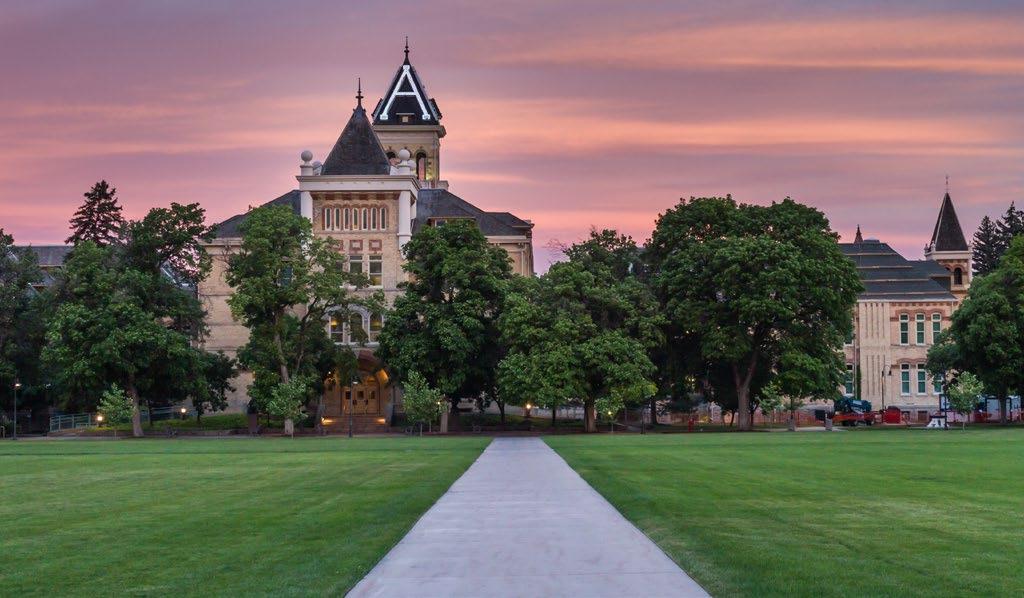
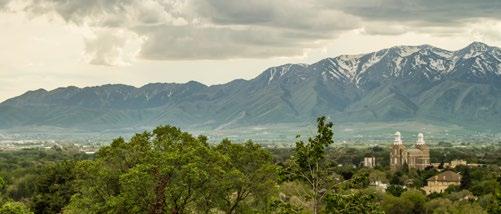

REGIONAL SPOTLIGHT
What’s the secret to Cache County’s economic success? It doesn’t boil down to just one thing. A well-educated workforce, surprisingly diverse economy given its size and location, a major university, and high quality of life are significant factors that contribute to the area’s success.
All these factors made 2020 a successful year for businesses relocating to and expanding in Cache County.
In May, Malouf, a bedding and furniture manufacturer and distributor, announced they would be expanding their corporate headquarters in Nibley, creating up to 1,195 jobs in the next 10 years. They also completed the acquisition of Downeast Home & Clothing, which has over 40 locations.
In December, Cytiva, a global provider of technologies and services that advance and accelerate the development and manufacture of therapeutics, announced it would be expanding its Logan location, creating up to 160 jobs in the next five years.
Other companies in diverse sectors expanding in Cache County include ThermoFisher, Roolee, ELITech, and Gossner Foods.
“We’re excited that these great organizations are growing and expanding in Cache Valley,” said Jamie Andrus, president and CEO of Cache Valley Chamber of Commerce. “We also see growth in the aerospace and tech sectors with the continued expansion of Electric Power Systems, Juniper Systems, and the Space Dynamics Lab at USU, to name a few.”
What’s prompting these national companies to make the northern tip of Utah home?
Cache County has immediate access to the outdoors, including hiking, fishing, hunting, and mountain biking in Logan and Providence Canyons. Beautiful Bear Lake offers nearby access to boating. Cache County also has two ski resorts, Cherry Peak and Beaver Mountain.
Logan, the county seat, provides various music and cultural attractions. The historic Ellen Eccles Theatre on Main Street hosts numerous musical and artistic performances throughout the year. Logan is also home to the American Festival Chorus and Orchestra. Cherry Peak resort’s summer concert series is fast-becoming known for its annual lineup of up-andcoming and well-known musical artists alike.
Cache County is also home to Utah State University, rated “The Most Beautiful College in Utah” by Travel + Leisure in 2019. The university provides a world-class education for students and a work-ready talent pool for businesses.
Short commute times, suburban living without suburban drawbacks, and a strong sense of community round out all the benefits Cache County has to offer.
But all these successes don’t come without some challenges. For example, while a low unemployment rate is great news for job seekers, businesses can struggle to find the right talent.
Cache County recently hired Shawn Milne as the new economic development director to find solutions to filling these jobs when the unemployment rate is down.
“There’s a wonderful environment for businesses in Cache Valley,” said Milne. “Our area’s successful employers are those that see the advantage in offering localized employment for such a desirable workforce. It’s a win-win-win for growing businesses, residents who would love to work closer to home, and a business-friendly community.”
The county hopes to continue bringing jobs to the area to sustain the local economy and create opportunities to entice residents to stay in the area. With these plans for sustainable growth and diverse opportunities, the future is bright for Cache County.


REGIONAL SPOTLIGHT
Heber Valley
Reimagining Tourism’s Role in the Community

It’s no secret that Mother Nature played favorites in Utah. With stunning crystalline salt flats, elegant red rock formations and majestic peaks capped with The Greatest Snow on Earth ®, millions of visitors from around the globe are drawn here. The state’s $10 billion tourism industry, albeit impacted by the COVID-19 pandemic, is a testament to visitors’ strong desire to experience all Utah has to offer.
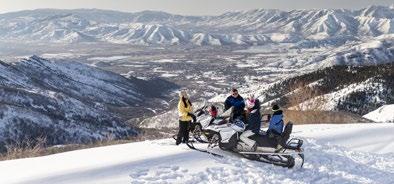

It’s not just visitors who are flocking to Utah. Since 2010, the state’s population has grown by 18%. These new residents are not only enticed by the booming job market, attractive and welcoming communities, and businessfriendly environment, but also by unparalleled access to the outdoors and recreation amenities in Utah.
Utah’s popularity comes at a price, however.
“With record-breaking domestic and international visitation in the Mighty 5® national parks, 44 state parks, 15 ski resorts, and millions
of acres of public lands along with explosive population growth and related development Utah is experiencing strains in several key destination areas,” said Vicki Varela, managing director of the Utah Office of Tourism. “Without responsible and careful tourism planning and promotion, these strains could degrade both the resident and visitor experience,”
Recognizing the need to market and manage Utah as a destination, the Utah Office of Tourism launched the Red Emerald
REGIONAL SPOTLIGHT BUSINESS.UTAH.GOV | @BUSINESSUTAH

Initiative in 2017. This long-term strategy for sustainable tourism growth promotes responsible visitation practices, including targeting quality visitors over quantity, distributing visitation statewide, and embracing community-led destination visions.
Through destination development planning grants and other services, the Utah Office of Tourism has worked with public and private stakeholders to support community-led visitor readiness. These efforts include guiding tourism growth to enhance the local economy while protecting residents’ quality of life.
One recent collaboration took place in the idyllic Heber Valley. Located in the Wasatch Mountains approximately 45 minutes from Salt Lake City between Park City and Provo, the Heber Valley has long been known as a calm, rural getaway with more dairies than
driveways. The extraordinary growth and development the Heber Valley has experienced tells a different story. In 2019, it was one of the fastest-growing areas in the country.
“Heber Valley is transforming,” says Dallin Koecher, executive director of the Heber Valley Office of Tourism. “Growth has brought new opportunities and jobs that didn’t use to exist. There are more opportunities for residents to work where they live with more access to amenities they used to have to leave the valley to acquire.”
For example, Lola’s Street Kitchen, a fast-casual restaurant that started as a food truck, is committed to providing meals made from scratch using local, organic, and highquality ingredients. Locally-owned and operated, Lola’s Street Kitchen meets local demand and builds wealth in the community.
Visitors, too, have been drawn to the area’s Olympic ski venues, three recreational reservoirs, and hundreds of square miles of backcountry wilderness. Familyfriendly attractions such as the Heber Valley Railroad and Midway Ice Castles bring thousands of

visitors each year. Utah’s newest ski area, the 6,800 acre Mayflower Mountain Resort, is currently under construction at the valley’s northern end. Once completed, it will offer thousands of residential units and hotel rooms along with 250,000 square feet of commercial and retail property.
BUSINESS IN UTAH | 2021 56
REGIONAL SPOTLIGHT

As the Heber Valley continues to grow and change, community leaders decided it was time to plan how to guide and manage tourism to the area, says Koecher.
“We felt now is the time to take control of our future,” he said. “This means maximizing what we have while protecting what we love about Heber Valley.”
The Heber Valley Office of Tourism, with grant assistance from the Utah Office of Tourism, created a strategic destination management plan to envision tourism’s role in the community over the next decade and outline the steps to achieve that vision.
In addition to the strategic plan, the Heber Valley Office of Tourism also created a new brand and messaging that will resonate with visitors who will stay longer, spend more at local businesses, and engage with the community.
“We had to be brave about the changes and ideas, and we had to be honest about our strengths and weaknesses,” said Koecher. “We were able to get some robust participation from our community leaders and business owners, which led to what we feel is a solid plan and brand.”
This forward-thinking planning will help the Heber Valley enjoy the benefits of tourism while also protecting the qualities that make it such a special place for those who live there. As the world continues to visit and move to cities, towns, and destinations around Utah, the Utah Office of Tourism will continue to promote responsible visitation, says Varela.
“As ambassadors for travel to Utah, our office is committed to being great stewards of our lands and communities,” Varela said. “Through thoughtful travel, we will keep Utah ‘Forever Mighty.’”
BUSINESS.UTAH.GOV | @BUSINESSUTAH 57
REGIONAL SPOTLIGHT
Abra Kanabra
The Magic of the West

Camille Johnson Taylor is a seventh-generation Kane County resident, and she could not be more proud. As director of the Kane County Office of Tourism, Taylor works tirelessly to promote the area’s attractions to tourists and locals while preserving the magic of an authentic, western community.
Taylor grew up in Kanab, graduated from Kanab High School, and then left town. She lived primarily on the Wasatch Front for nearly 18 years before moving back home to Kanab in 2011.
“This place has a gravitational pull. I think it’s the iron in the soil. It must be magnetic and pulls its own back home,” Taylor said jokingly.
Things fell into place for Taylor professionally, and she considers herself fortunate to be Kanab and Kane County’s number one paid cheerleader.
According to Taylor, the tagline ‘Abra Kanabra’ resurfaced every few years for several generations until the Kane County Office of Tourism made it one of its official taglines after she joined the tourism office.
“The brand is ‘Kanab—Magically Unspoiled,’ but the ‘Abra Kanabra’ tagline has almost trumped our brand,” said Taylor. “It’s catchy, memorable, and no one else can use it.”
Since joining the office over six years ago, Taylor has focused on attracting quality visitors who stay longer, spend more money, and
are more culturally connected. Recent advertising campaigns center around culture as well as promoting the county’s jawdropping landscape.
“Kanab and Kane County offer an authentic, connective traveler experience. It may be the scenery that brings visitors here initially, but it’s our people and our culture that bring them back,” Taylor said. “As people explore areas closer to home since the COVID-19 pandemic, Kane County is wellpositioned because of its central location.”
BUSINESS IN UTAH | 2021 58
REGIONAL SPOTLIGHT

When John Wesley Powell created the system for mapping the United States as the U.S. Geological Survey director back in 1869, Powell designated Kanab as the actual “Center of the West.”
“Kanab is a great basecamp for exploration because it offers incredible hiking, world-class dining, and friendly locals that make you feel at home,” said Taylor.

During the COVID-19 pandemic, the community spirit of Kane County helped limit the spread of coronavirus. Taylor led an ad-hoc committee, under the Kane County Commission’s direction, to safely re-open the economy when the time came. The tourism office, hospital, health department, Chamber of Commerce leadership, and local businesses created the first community-led initiative in the state, called the “Above and Beyond Promise” initiative.
This collaborative and multi-faceted approach included encouraging residents to wear masks, wash their hands, social distance, and follow other Centers for Disease Control public health measures. When businesses “opted-in” to this initiative, staff were required to attend a class on hospitality training. Upon completing the training, each company was given a kit that included “Abra Kanabra” branded masks, posters, tent cards, and a decal of the “Above and Beyond Promise” to put on the establishment’s front door or window.
Kane County was the first county to achieve green under the state’s previous color-coded system for assessing coronavirus spread and subsequently maintained the equivalent “low” designation. While Utah experiences a rise in cases, Kane County is still the lowest risk county in the region.



BUSINESS.UTAH.GOV | @BUSINESSUTAH 59
REGIONAL SPOTLIGHT
T H I N K
MOAB




Price
A Town of Endless Opportunities
By: Mike Kourianos, Mayor of Price
Situated on Highway 6 between Spanish Fork (I-15) and Green River (I-70), Price, Utah is at the heart of Utah’s scenic adventure and recreational landscapes. The county seat of Carbon County, Price was settled by Greek, Italian, Eastern European, Mexican, Japanese, and many other ethnic and religious groups who came to the area to mine. It is a culturally diverse community like no other in rural Utah.


But that’s just the elevator speech. There is so much more to Price. Indeed, Price is the right place for many things!
REGIONAL SPOTLIGHT
Fremont Indian petroglyph in Nine Mile Canyon (near Price, Utah)
BUSINESS.UTAH.GOV | @BUSINESSUTAH
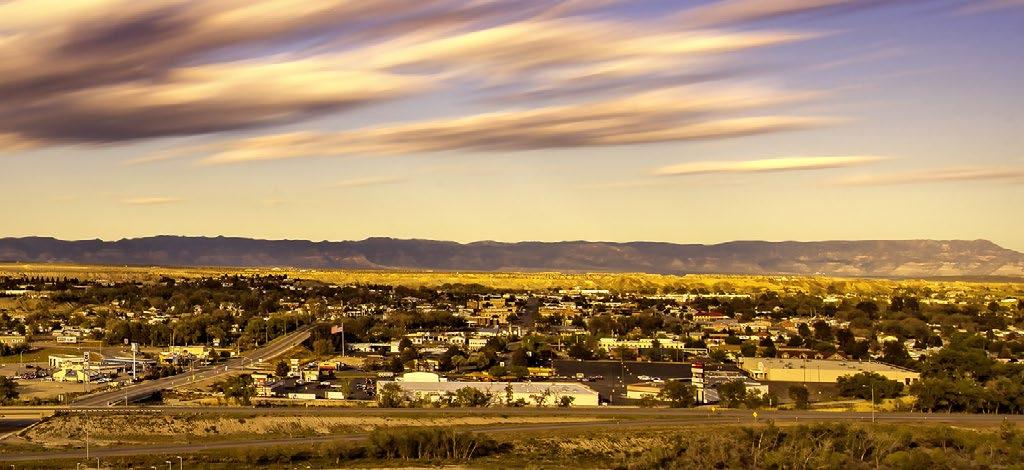

Education
The people of Price know the value of education in all its forms. College students in the area receive a world-class education at Utah State University Eastern. USU Eastern is part of Utah State University’s regional campus system, which fulfills USU’s larger “land grant” mission. Whether individuals are looking for short-term technical training or need an associate, bachelor’s, or master’s degree, USU Eastern has the right pathway to help people pursue their educational and career goals.
An Emerging Workforce
Price has a superior broadband infrastructure that keeps it connected to regional, national, and international markets. Because of this extraordinary asset, Price has a growing remote workforce and is doing more to help local people secure remote jobs. These are good, high-paying positions with some of the state’s — and the nation’s — top businesses and technology companies. With COVID-19 driving change in how and where people work, there is a substantial opportunity for Price to participate in this new remote workforce economy.
Recreation
Price is a diamond in the crown of Utah’s great outdoors and provides residents and visitors with endless recreational opportunities that add tremendous value to the quality of life. Price is within striking distance of Nine Mile Canyon, Cleveland Dinosaur Quarry, Scofield and Huntington Reservoirs, the San Rafael Swell, and many other little known hide-a-ways that residents are more than willing to share. Price is always ready to accommodate the explorer and adventure seeker.
Destination Opportunities
Price is routinely recognized as a prime location for retirement. Its low tax burden, access to highquality medical care, recreation opportunities, education, and culture and arts community all make Price the second most attractive community in the state for retirement—behind Park City.
Last but not least, Price has an indomitable spirit of resilience and optimism and continues to overcome every obstacle thrown in its way. The town and its residents are committed to innovation in technology, excellence in higher education, and “high-touch” hospitality. Most importantly, Price is eager to welcome and work collaboratively with residents, visitors, and businesses that share its passion for growth, innovation, and progress.
REGIONAL SPOTLIGHT BUSINESS IN UTAH | 2021 62
Vernal’s Innovation Hub

How One Rural Utah Community Successfully Opened a Coworking and Innovation Center During an Economic Downturn
REGIONAL SPOTLIGHT

The Innovation Hub in Vernal announced its grand opening in early February 2021. The Hub attracts coworkers, online rural workers, entrepreneurs, start-ups, and business networking and will diversify the Uintah Basin economy by inspiring and incubating local talent.
The Innovation Hub evolved from idea to completion despite a downturn in the local economy. Uintah County currently has the highest unemployment rate in Utah, with 11% unemployment due to the coronavirus pandemic and the reduction of oil and gas jobs.
The Hub started three years ago when about 20 community leaders joined together to take a significant step in diversifying an economy heavily reliant on the oil and gas industry. A committee was formed representing 12 area entities in addition to small tech businesses and entrepreneurs. The group recognizes the Basin’s future economy must incrementally move to non-energy production job creation by targeting online workforce opportunities, small business creation, and technologybased businesses.
Uintah County Commissioner Bart Haslem said, “This has been a great project to be a part of. The resources that we are making available to the community can help change our economy in a very positive way.”
The vision for a Coworking and Entrepreneur Center received a significant boost in June 2019 when the Governor’s Office of Economic Opportunity solicited grant applications for rural coworking and online innovation centers. The Uin-Tech Committee submitted a grant with renderings and received $223,000 toward the construction. With additional funds from the county, city, and Strata Networks (the Basin’s high-speed fiber provider), the Hub underwent a major remodel.
The Innovation Hub is located on Main Street in a former two-story city police department building, vacated nine years ago. The renovation project was designed and constructed by Vernal City
and Uintah County building facility employees to reduce cost. The grant funds were used for construction materials, railings, network, wifi, finishings, and furnishings.
The Hub is nearly complete with 7,000 square feet of workspace and networking areas. It consists of shared office areas, two conference rooms, an event/training room, flex space, a podcast room, phone booths, and a break room. The Hub boasts a 1GB internet connection with impressive download and upload speeds.
Membership at the Hub is tiered similar to other coworking spaces: private office ($199 a month), dedicated desk ($99 a month), flex desk ($49 a month), community member, and daily pass ($5). Access to the center is 24/7 for members with a phone app called Proximity. Existing and established businesses are not eligible for private offices.
The Hub is currently adding members with all five private offices rented. As the center nears completion, promotional materials will boost the center’s exposure and what it offers to small start-ups and the local economy.
The Hub’s development is a prime example of partnerships between state and local entities to accomplish a community goal.
More information about Vernal’s Innovation Hub is found at vernalinnovationhub.com.
BUSINESS IN UTAH | 2021 64
REGIONAL SPOTLIGHT
Utah Regional Economic Development Offices
Beaver County Economic Development
105 East Center Street, PO Box 789 Beaver, UT 84713 (435) 438-6490
beaver.utah.gov
Box Elder County Economic Development
1 South Main Street Brigham City, UT 84302 (435) 734-3331
boxeldercounty.org
Cache Valley Chamber of Commerce
179 North Main Street Logan, UT 84321 (435) 755-1891
cachechamber.com
Carbon County Economic Development
751 East 100 North Price, UT 84501 (435) 636-3295
carbon.utah.gov/ecodev
Cedar City – Iron County Economic Development
10 North Main Street Cedar City, UT 84720 (435) 586-2770
cedarcity.org
Daggett County Economic Development
95 North 100 West, PO Box 219 Manila, UT 84046 (435) 784-3218
daggettcounty.org
Davis County Economic Development
61 South Main Street, Suite 304 Farmington, UT 84025 (801) 451-3216
daviscountyutah.gov
Duchesne County Economic Development
50 East 200 South Roosevelt, UT 84066 (435) 722-4598
uintabasin.org
Emery County Economic Development
75 East Main Street #117 Castle Dale, UT 84513 (435) 381-5576
emerycounty.com
Garfield County Economic Development
55 South Main Street, PO Box 77 Panguitch, UT 84759 (435) 676-1157
garfield.utah.gov/departments/planningeconomic-development
Grand County Economic Development
84 North 100 East Moab, UT 84532 (435) 259-1371
grandcountyutah.net
Heber Valley Tourism and Economic Development
475 North Main Street Heber City, UT 84032 (435) 654-3666
gohebervalley.com
Juab County Economic Development Agency
160 North Main Street Nephi, UT 84648 (435) 623-3415
juabcounty.com
Kane County Economic Development
76 North Main Street Kanab, UT 84741 (435) 899-4403
kane.utah.gov
Millard County Economic Development Association
71 South 200 West Delta, UT 84624 (435) 864-1407
millardcounty-ecdev.com
Morgan County Economic Development
48 West Young Street Morgan, UT 84050 (801) 829-6811
morgan-county.net
Piute County Economic Development
550 North Main Street Junction, UT 84740 (435) 577-2840 piute.org
Rich County – Bear Lake Regional Commission
69 North Paradise Parkway, Bldg. B Garden City, UT 84028 (435) 946-2198
bearlakeregionalcommission.org
Salt Lake County Economic Development
2001 South State Street, Suite S2-100 Salt Lake City, UT 84114 (385) 468-4887
slco.org/economic-development
San Juan County Economic Development and Visitor Services
117 South Main Street, PO Box 490 Monticello, UT 84535 (435) 587-3235
utahscanyoncountry.com
Sanpete County Economic Development Association
191 North Main Street, PO Box 148 Manti, UT 84642 (435) 835-4321 sanpete.com
Sevier County Economic Development 250 North Main Street, Room 116 Richfield, UT 84701 (435) 893-0454 sevieredc.com
Summit County Economic Development 60 North Main Street, PO Box 128 Coalville, UT 84017 (435) 783-4351 summitcounty.org
Tooele County Economic Development 47 South Main Street Tooele, UT 84074 (435) 843-3253 tooeleco.org
Uintah County Economic Development 152 East 100 North Vernal, UT 84078 (435) 781-6767 vernalutah.org
Utah County Economic Development 815 West 1250 South Orem, UT 84058 (801) 863-7546 utahcounty.gov
Washington County Economic Development
1071 East 100 South, Bldg. C, Suite 7 St. George, UT 84770 (435) 652-7750 washco.utah.gov
Wayne County Economic Development 18 South Main Street, PO Box 189 Loa, UT 84747 (435) 836-1315 waynecountyutah.org
Weber Economic Development Partnership
2380 Washington Blvd., Suite 250 Ogden, UT 84401 (801) 399-8414
co.weber.ut.us/weberedp


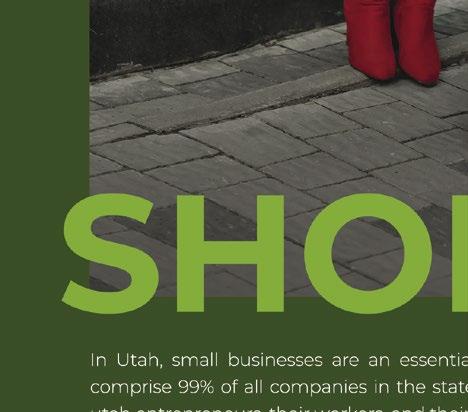


REGIONAL SPOTLIGHT BUSINESS.UTAH.GOV | @BUSINESSUTAH







2021 66
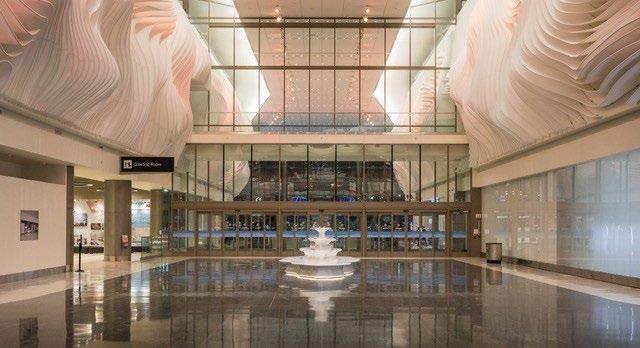
Utah’s Top 10 Economic Development Stories in 2020
By: EDCUtah
Without a doubt, the top economic story of 2020 was the pandemic, and there was not much good news.
But, believe it or not, there were many other stories of great companies and incredible individuals that left their indelible mark on Utah’s economic landscape — and left us with milestones worth celebrating. Many of these successes involved the Economic Development Corporation of Utah (EDCUtah), the Governor’s Office of Economic Opportunity (Go Utah), and other economic development partners.

Here are Utah’s Top 10 economic development stories of 2020, in chronological order:
1. Northrop Grumman announces Project Unity, a Ground Based Strategic Deterrent (GBSD) expansion in Weber County, supported by a state tax credit incentive. Northrop Grumman is currently the largest security and defense company in Utah, with more than 5,100 employees across the state. The GBSD headquarters will add 2,250 jobs and capital expenditures of $380 million over 20 years.
2. Procter & Gamble (P&G) expands operations in Box Elder County with Project Syrup19. In 2011, Utah was home to P&G’s first domestic greenfield manufacturing site expansion in decades. This latest news marks the third time the company has expanded its Utah facilities.
BUSINESS.UTAH.GOV | @BUSINESSUTAH 67
Economic Development Partners
The project represents an additional 221 jobs and capital expenditures of $310 million over 20 years. P&G received a state tax credit incentive for its latest expansion.
3. The Northern Utah Economic Alliance (NUEA) regional economic development group announces its name. Founded in 2019 and supported by EDCUtah and Go Utah, NUEA brands and promotes the Northern Utah region, representing nearly 20 percent of Utah’s total population and economy. NUEA’s core mission is to create high-paying jobs in targeted industries to sustain long-term growth for the region. NUEA’s goals to accomplish this mission include showcasing Davis and Weber counties to attract new businesses in aerospace, technology, outdoor products, and other high-growth industries. Learn more at nuea.org.
4. Thanks to new legislation, the Sales & Use Tax Exemption, Utah’s Data Center industry accelerates with the announcement of the new Novva campus in West Jordan. This legislation puts Utah on a par with Oregon and other states active in the industry.
5. The new Salt Lake City International Airport — a $4.1 billion project — opens ahead of schedule. Delta occupies all 25 gates in Concourse A, including the six international gates. Concourse B has 20 gates for Alaska, American, Frontier, JetBlue, Southwest, and United airlines.
6. With the Northwest Quadrant (NWQ) Mega Site certification in Salt Lake City, EDCUtah’s Mega Site program now has 10 sites statewide. The NWQ site anchors the state’s emerging Inland Port.
7. After extensive training coordinated by EDCUtah , eight Utah communities become “Development Ready” certified, promising efficient and comprehensive responses to potential economic development projects.
8. Spencer Cox is elected as Utah’s 18th governor and taps State Senator Dan Hemmert as the new head of Go Utah upon outgoing director Val Hale’s retirement in early January 2021.
9. Colby Cooley is promoted to EDCUtah’s vice president of business development. Previously, Cooley ran EDCUtah’s Global Strategy & Outreach program.
10. After dozens of projects hit “pause” in March, EDCUtah sees the endof-year pipeline climb back to a typical level of 95 active economic development projects. More than half of these focus on manufacturing and distribution, a new record. Read more in EDCUtah’s Industry Profile.
In addition to these successes, EDCUtah staff assisted the state of Utah’s pandemic response efforts throughout most of 2020. The nine months of work culminated in December with a donation of 1 million+ face masks for disadvantaged children, facilitated by EDCUtah.
For more information, contact Colby Cooley, vice president of business development, at ccooley@edcutah.org.


BUSINESS IN UTAH | 2021 68
Utah’s Path To Economic Recovery Runs Directly Through Global Markets
By: World Trade Center Utah
Despite the pandemic’s unprecedented global economic disruption—or perhaps because of the opportunities hidden within the crisis—Utah’s path to economic recovery and revitalization runs directly through global markets, just as it did a decade ago.
Businesses that export grow faster during economic expansions and are far more resilient during economic downturns. The United States International Trade Commission reported that during the 2008-2009

financial crisis, small and medium-sized businesses that exported had more than twice the total revenue of their non-exporting counterparts. These exporters had revenue growth of 37% between 2005 and 2009, while total revenue declined by 7% for non-exporting businesses over the same period.
International trade and investment now support nearly one in every four jobs in Utah, with small businesses accounting for 85% of Utah’s exporters. Last year, international sales added nearly $5 billion in additional revenue for these small business exporters, and Utah’s export growth rate has led the nation for the past two years.
UAEInbound18: 2018 Business tour of Utah for the Trade and Commercial Office at the Embassy of the United Arab Emirates (UAE) and Commercial Counselor for the UAE to the United States of America.
BUSINESS.UTAH.GOV | @BUSINESSUTAH 69
Partners
Economic Development
RuralBootCamp:
WTC Utah Director of Business Development
Jim

Clearly, there are significant global opportunities for Utah companies and important public benefits for internationalizing our economy. Yet, the world is a big place and international business can be daunting. The good news is that Utah businesses don’t have to go it alone.
World Trade Center Utah (WTC Utah) is dedicated to accelerating growth for Utah’s new-to-export businesses and the 3,500 Utah small and medium-sized enterprises that are already competing and winning on the global stage. With the launch of its newly enhanced Global Business Services, the organization can plug in at any stage of a business’s international expansion to catalyze growth while also mitigating risk.
WTC Utah’s Global Business Services team builds on the capabilities
WTC Utah has developed over many years of helping Utah businesses grow in markets around the world through increased global sales and investment. The organization has always provided businesses with consultations, data-driven insights and grant funding. Now, in partnership with service providers in Utah and around the world, it also offers market research, strategy development, translation, logistics, freight forwarding, global matchmaking and more.
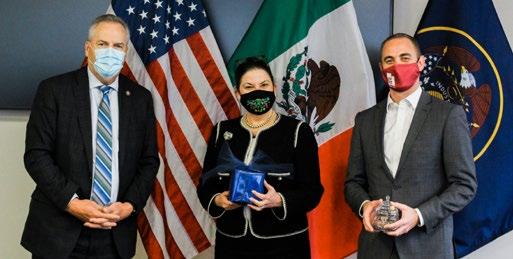
WTC Utah assesses a company’s preparation, strategy and capabilities before the company invests in international expansion. After providing data-driven advice to help develop an international expansion strategy, WTC Utah and its partners deliver services to help companies develop a website, refine their marketing strategy, move product, become legally compliant, and connect with potential partners and customers in markets around the world. The organization also administers public and private grant programs that are designed to bolster global growth for small Utah businesses, especially those in rural Utah and the state’s multicultural communities.
In addition to offering a full range of products and services to help enter and expand in global markets, WTC Utah can also help Utah companies find capital to finance that growth.
Companies ready to go global or expand their current international engagement are able to connect with WTC Utah at any stage to gain a partner with deep expertise that is dedicated to catalyzing the company’s success.
To learn more about how WTC Utah can help your business go global, visit wtcutah.com
BUSINESS IN UTAH | 2021 70
Porter hosting an Export Bootcamp in Pric, Utah (2019).
Mexican Ambassador to the U.S. Martha Bárcena following the Utah Economic and Energy Summit. Also pictured: Val Hale, former director of the Governor’s Office of Economic Development, and Miles Hansen, president and CEO of WTC Utah. (2020)
 David Carlebach, Vice President of International Investment for World Trade Center Utah
David Carlebach, Vice President of International Investment for World Trade Center Utah
Utah: A Global Hub for Investment
With David Carlebach , Vice President of International Investment World Trade Center Utah
Here’s a tip for global investors: Utah is at the tipping point!
With recognition from Forbes as the ‘Best State for Entrepreneurs’ (2019), a new international airport, and the development of an inland port that will revolutionize global logistics, Utah is getting a lot of attention. More than just taking notice, global investors want in on the action.
Utah businesses receive between $1 to $2 billion in foreign direct investment (FDI) each year. What’s more, about 50,000 Utah jobs are directly associated with foreign-owned companies. While these numbers are encouraging, there’s room for growth.
New FDI has a significant impact on many aspects of Utah’s economy. The extra capital that accompanies international investment leads to growth and a rising tide of employment, taxes, infrastructure, and more that benefits the entire state.
“As Utah emerges a global hub for trade, investment, and innovation, it’s transforming from its traditional role as the ‘Crossroads of the West’ into its future as the ‘Crossroads of the World,”’ said Miles Hansen, president and CEO of World Trade Center Utah (WTC Utah). “Connecting local companies and investment opportunities with international investors is a win-win-win for the local companies, the international partners, and all of us in the state thanks to the many benefits of international investment.”
WTC Utah works to attract global investment and facilitate international partnerships to fuel innovation and business development. It focuses on technology, life sciences, and clean energy. Given the state’s diverse economy, WTC Utah gets involved in other industries, too.
Our broad approach to FDI entails working with partners, including the Governor’s Office of Economic Opportunity and EDCUtah, to encourage international companies to create new establishments in Utah, and invest in existing businesses.
Additionally, we promote opportunities for SMEs/startups to enter the U.S. market in Utah and institutional investors to invest in Utah VC funds. We support Utah startups directly and provide private support for public infrastructure projects.
BUSINESS.UTAH.GOV | @BUSINESSUTAH 71
Development Partners
Economic
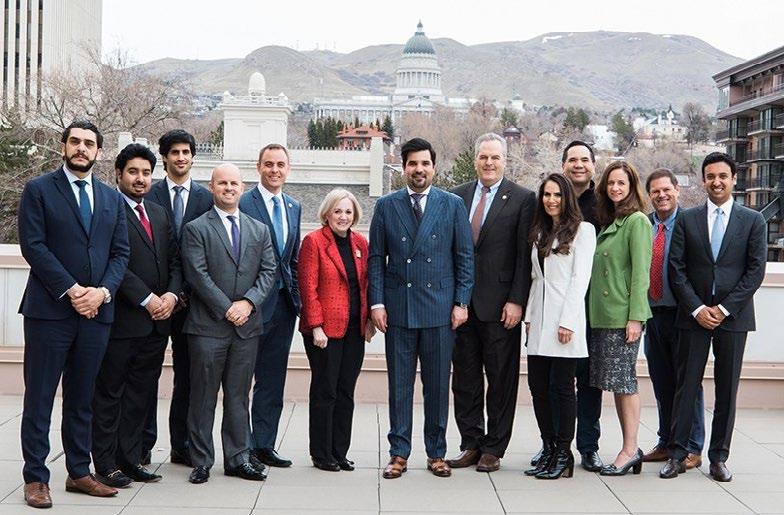
For example, an exciting, privately funded infrastructure project is happening right in the heart of Silicon Slopes: a world-class sustainable land reclamation project at Utah Lake. Over the coming years and decades, the project is expected to create 20,000 acres of new land and housing — much of it affordable housing — for up to 500,000 residents.
Utah has had the fastest growing GDP in the U.S. over the last decade. Fortunately, the state has the human capital to support this, thanks to the youngest and fastest-growing population in the country.
Given the high quality of life in Utah, we have strong net inward migration from other states. In fact, 40% of our population growth comes from other states.
Together with Utah’s economic development partners, WTC Utah is committed to connecting Utah companies with global opportunities. To learn more, visit wtcutah.com or connect with me directly at dcarlebach@wtcutah.com.
BUSINESS IN UTAH | 2021 72
Water investment delegation led by the Qatari Investment Authority, Qatar Ambassadors, and the US-Qatar Business Council. (2019)


Education
Utah’s population is young and growing, which means an impressive number of students get their start in the state’s education system. Through innovative programs in K-12 education, higher education, and other post-secondary education, those students become well-prepared members of the state’s expanding workforce. An educated workforce has economic benefits for individuals and companies today and in the future.
BUSINESS.UTAH.GOV | @BUSINESSUTAH 73

During the 2020-21 school year, the legislature allocated 50% of Utah’s statewide budget to education, making Utah’s education spending ninthhighest in the nation. Utah has 666,858 K-12 students enrolled in more than 1,000 public schools and 130 charter schools, which serve about 11% of all Utah public school students.
Over 220 Utah schools offer dual language immersion programs in six different languages: French, German, Mandarin, Portuguese, Russian, and Spanish.
The increase in ongoing (state-directed) public education funding from 2010 to 2020 is approximately $2 billion, supporting high-quality education for students throughout Utah. Statewide, Utah’s high school graduation rate increased from 84.7% in 2015 to 87.4% in 2019.
Utah ranks fourth in the country for reading proficiency in 4th-graders, according to the National Assessment of Educational Progress (NAEP) ratings.
In science, Utah 8th graders’ mean score is No. 1 in the country.
Utah high school students earned 323,749 concurrent enrollment credits in the 2019-2020 school year, which is nearly 11.7% more than the previous year. It is estimated students saved $62.7 million in future tuition expenses through concurrent enrollment.
Utahns value higher education and recognize a college degree contributes to individuals’ and communities’ economic prosperity. More than 230,000 people, or 7.2% of the state’s population, are enrolled in a public postsecondary technical college or degree-granting institution.
As of 2020, over half of Utahns (53%) between ages 25 and 64 have a college degree or certificate.
Utah’s public four-year institutions ranked third-lowest in the nation for cost of in-state tuition and fees in 2019-2020. On average, Utah students pay $7,160 per year. Thanks to that low tuition, Utah graduates have the lowest debt rate in the country. Only 36% of Utah college graduates have student loan debt, contributing to Utah’s vibrant middle class.



BUSINESS IN UTAH | 2021 74

Workforce

The state’s educated and youthful workforce helps Utah companies thrive. Utah is a right-to-work state, places a high value on education, and has the nation’s youngest demographics. This combination delivers a workforce eager and ready to meet the needs of any industry.
Job Growth Rate — Utah’s employment grew by 3.3 % between Dec. 2018 and Dec. 2019, while the national growth rate was 1.4%.
Unemployment Rate — Utah’s unemployment rate was 2.3 % in Dec. 2019.
Jobs Gained — Utah gained 50,400 jobs between Dec. 2018 and Dec. 2019.
Average Non-Farm Wage — The average wage was $49,619 in Jan. 2020.
Economic Leadership and Job Growth
Utah’s prosperity is not limited to a handful of industries. Nearly every private sector industry in the state saw growth in 2019. The fastest-growing industries in Jan. 2020 were:
• Leisure and Hospitality Services (7.5%)
• Construction (7.3%)
• Information (7.1%) — Includes publishing, motion picture and sound recording, telecommunications and internet service providers
Source: Utah Department of Workforce Services
A Prepared Workforce
Utahns embrace education as a means for personal growth and career advancement, which means the state’s talent pool is wellinformed and prepared to meet industry’s needs. Additionally, 100% of both personal and corporate Utah state income tax dollars are spent on education.
Among Utah adults, 91.8% have earned at least a high school degree, compared to the national average of 88%. Among Utahns age 25 and older, 32.5% have a bachelor’s degree or higher.
Source: U.S. Census Bureau, American Community Survey, 2017 5-year estimates
BUSINESS.UTAH.GOV | @BUSINESSUTAH 75
Utah’s Targeted Industries
Utah strategically pursues business growth in eight target industry sectors that contribute to its diversified and robust economy. The eight sectors are:
• Advanced Manufacturing
• Aerospace and Defense
• Energy
• Financial Services
• Life Sciences and Healthcare Innovation
• Outdoor Products and Recreation
• Software and Information Technology
• Tourism and Film
Utah’s Largest Employers
Some of the state’s largest private employers include:
• America First Credit Union
• ARUP Laboratories, Inc.
• Autoliv
• C.R. England Trucking
• Delta Airlines
• Discover Products, Inc.
• Goldman Sachs
• Intermountain Healthcare
• JetBlue Airways Corporation
• L3 Technologies
• Northrop Grumman Corporation
• SkyWest Airlines
• Vivint
• Wells Fargo Bank
• Zions Bancorporation
List alphabetized; public and retail employers omitted
Source: Utah Department of Workforce Services, Top 50 Employers

Silicon Slopes
Stretching from Logan to St. George, Silicon Slopes is a statewide organization and the voice, hub and heart of Utah’s startup and tech communities. The organization empowers Utah’s startup and tech companies to learn, connect and serve to make entrepreneurship and opportunity accessible to all.
Utah’s Silicon Slopes is a vibrant, diverse, global innovation hub with some of the world’s greatest entrepreneurs and companies.
A Multilingual Workforce
In Utah, an unusually high number of residents (per capita) have lived abroad, giving the workforce deep cultural insights into foreign countries.
• Approximately 70 % of students at Brigham Young University are multilingual
• 50 + languages are taught at Utah universities
• 120 + languages are spoken in daily commerce in the state
Talent Ready Utah
A nationally recognized program, Talent Ready Utah, connects business and education partners to develop specific skills in Utah’s workforce. Many programs, such as Utah Aerospace Pathways, Utah Diesel Tech Pathways, and Medical Innovations Pathways, bring both industry and education partners to the table.
Talent Ready Utah provides internships and job shadow opportunities to high school students as they take courses geared toward certain professions, and students earn guaranteed job interviews with participating employers.
Programs managed by Talent Ready Utah, such as Utah Works, provide additional state-sponsored workforce solutions for employers.


BUSINESS IN UTAH | 2021 76

Government
Utah has a business-friendly environment that fosters innovation and growth. It boasts one of the strongest U.S. state economies.
No. 1
• Recent rankings from Forbes and Amazon say Utah is the No. 1 state for entrepreneurs
• In Aug. 2020, 24/7 Wall St . ranked Utah the No. 1 Best Economy
• WalletHub ranked Utah the “Most Independent State” in 2020
• In 2019, FOX Business and The Heritage Foundation named Utah the state with the best economic outlook; Utah has held the No. 1 spot since 2012
• In Dec. 2019, The Wall Street Journal named Utah “America’s economic star”
• SmartAsset ranked Utah the No. 1 state for the middle class in 2019
• For a decade, Forbes has ranked Utah a top-three Best State for Business, including six times in the No. 1 spot
No. 2
• Salt Lake City is ranked as the No. 2 “Best Place in America to Start a Business” according to Inc. (2019)
• In its 2019 Best States Rankings, U.S. News & World Report ranked Utah No. 2 for the best economy
A+
In 2019, Thumbtack gave Utah an A+ rating for “Small Business Friendliness.”
Leading the Way
Utah doesn’t take economic growth for granted. While enjoying an already exceptional economic and business climate, state leaders continue to invest in strategic growth.
Most Positive Outlook
According to Gallup, Utahns have the most positive outlook about their state’s economy.
AAA Bond Rating
On May 18, 2020, S&P Global, Moody’s Investors Service, and Fitch Ratings reaffirmed Utah’s AAA credit rating, the highest rating a state can receive.
Utah’s history of continuous AAA bond ratings dates back to 1965 when S&P initiated its rating system. The state’s AAA rating with Moody’s commenced in 1973 and with Fitch Ratings in 1992.
BUSINESS.UTAH.GOV | @BUSINESSUTAH 77
Rationales cited for Utah’s AAA rating include:
• Strong government framework, with a constitutional requirement to maintain a balanced budget and fiscal policy that allows for changes to the revenue structure and program spending with a simple majority of the legislature.
• Conservative fiscal and debt management policies that include constitutional or statutory limits on appropriation growth and debt issuance to keep debt levels low and quickly amortizing, despite the demands of population growth.
• Continued leadership in management and funding of long-term liabilities for pensions and other post-retirement benefits, leading to low fixed costs relative to its peers, and contributing to the state’s good budgetary flexibility.
• Successful and timely action when addressing budgetary imbalances.
• Reserve funds that accumulate based on a statutorily determined formula.
• Job growth across most major sectors, including solid growth in trade, transportation and utilities.
• An unemployment rate typically well below the national average.
• Annual real gross domestic product growth that has continuously surpassed the nation’s since 2013 and is expected to continue to outperform the nation due to a favorable industry mix and steady population growth.
Vibrant Cities and Towns
Utah’s cities and towns are vital engines of economic growth.
In 2020, the Milken Institute named several Utah cities in its list of Best-Performing Cities:
Provo-Orem ( No. 2)
Ogden-Clearfield ( No. 22)
Salt Lake City ( No. 25 )
Logan was No. 3, and St. George was No. 4 in the Institute’s Small-Metro rankings.
Forbes ranked three Utah cities within the top 25 of its 2019 “Best Places for Business and Careers” list:
Provo ( No. 6)
Ogden ( No. 16)
Salt Lake City ( No. 21)



BUSINESS IN UTAH | 2021 78

International Reach
The governor’s International Trade and Diplomacy team within Go Utah partners with World Trade Center Utah to assist Utah companies with global market development. Services include:
• Business mentoring
• Educational seminars
• In-country trade representatives
• International trade missions
• Key international business connections
• Marketing strategy consultations
• Recruitment of foreign investors
In 2019, the last year conditions allowed us to travel and host diplomats, Go Utah’s International Trade and Diplomacy team hosted 104 visits from ambassadors and other high-level diplomats. This is the team that provides international diplomatic support for the state’s governor.
World Trade Center Utah
The Governor’s Office of Economic Opportunity contracts with World Trade Center Utah (WTC Utah), a licensed and certified member of the World Trade Centers Association headquartered in New York City, to help Utah companies of all sizes succeed in global markets.
WTC Utah pursues its mission in tandem with Utah businesses, state and local governments, federal agencies, civic and economic development organizations, industry associations, chambers of commerce, and educational institutions.
BUSINESS.UTAH.GOV | @BUSINESSUTAH 79
Utah vs. National Unemployment Rate | November 2020 4.3% Utah 6.7% U.S. 4.0% 3.0% 2.0% 1.0% 0.0% -1.0% 2010 2011 2012 2013 2014 2015 2016 2017 2018 Unemployment Growth Rate in the U.S. and Utah | 2010 - 2018 Utah U.S Source: Bureau of Labor Statistics 10% 8% 6% 4% 2% 0% 2009 2010 2011 2012 2013 2014 6.2% 3.7% 2.9% 9.3% 7.3% 3.8% 2015 2016 2017 2018 2019 U.S. and Utah Unemployment Rate | 2009 - 2019 Utah U.S Economic Dynamism Source: Bureau of Labor Statistics
WTC Utah is proud to provide strategic leadership on international engagement to this statewide network, elevating Team Utah’s work to a global level to support partner efforts at home and abroad, promote prosperity, and build economic resilience.
WTC Utah’s primary objectives are to:
• Empower Utah businesses to expand international sales to increase revenue and create jobs.
• Attract foreign investment and facilitate international partnerships to fuel innovation and business development.
• Mobilize Utah’s international engagement to elevate its global status.
WTC Utah supports Utah companies in their international business development. Services include:
• Export training, including market intelligence and one-on-one counseling from a network of trade and industry experts.
• Introductions to Utah companies, funds, and projects for foreign investors and partners.
• Outreach to leverage statewide networks of businesses, investment institutions, government leaders, and business organizations.
• International trade missions and trade show support.
• National resources and grant administration to receive funding and pursue international sales and investment opportunities.
• Rural international trade and investment support.
• In-depth market research and partner support to assist and inform Utah companies during each phase of their global entry and expansion.
WTC Utah is part of an international network of more than 300 World Trade Centers operating in 90 countries and supported by 15,000 WTC professionals who deliver reciprocal resources to WTC members. This trade and investment ecosystem helps make doing business around the world as easy as doing business across the street.
“What Utah has to offer through our innovative workforce and industry leaders is boundless. Utah companies ready to pursue global opportunities have a strong partner in WTC Utah. WTC Utah’s services and support can be applied at any point to accelerate growth for Utah businesses. By taking Utah to the world one company at a time, we build a stronger Utah for tomorrow.”
– Utah Gov. Spencer J. Cox
“Since going international with the help of World Trade Center Utah, our global sales have grown 750%, and our total revenues have doubled. Learning to compete and win internationally has helped us become more competitive at home.”
– Natalie Kaddas, CEO, Kaddas Enterprises
Business–Building Initiatives
Utah provides a diverse suite of incentives to businesses that expand or relocate to the Beehive State. Here’s a sampling of incentives:
Economic Development Tax Increment Financing
Known as EDTIF, this program was created by Utah’s Legislature to foster and develop key industry sectors in Utah, provide additional employment opportunities, and improve the state’s economy. EDTIF offers a tax credit of up to 30% of new state taxes paid for up to 20 years to companies that create at least 50 jobs that pay wages of 110% of the county average. Contracts are postperformance, only providing a state tax credit if the company meets its obligations.
Industrial Assistance Fund
A post-performance grant for creating new high-paying Utah jobs. Grants are available for approximately five years in four different categories:
1) Urban
2) Corporate Headquarters
3) Economic Opportunities
4 ) Rural
Motion Picture Incentive Program
A post-performance tax credit or cash rebate of production dollars spent in-state. Requires hiring 75-85% local cast and crew. Productions spending at least $1 million may qualify for a 25% rebate. Productions spending under $1 million may be eligible for a 20% rebate.
≥$1m = 25%; > $1m = 20%

BUSINESS IN UTAH | 2021 80

Population
Utah is America’s 30th most populous state and, over the past decade, has experienced the most population growth of any state with 18.3% percent growth. Only the District of Columbia grew more than Utah in the same period (19.1%). With well over three million residents, Utah is poised to continue its growth from natural increase (births minus deaths) and net migration — representing two-thirds and one-third of population growth, respectively. Some projections estimate the state will have 5.8 million residents by 2065.
Utah’s economic dominance and high quality of life continue to fuel growth and opportunity. The state’s population remains the youngest in the country — the median age in Utah is 30.7 compared to the national average of 37.9. This youthful population will continue for generations, ensuring a vibrant future workforce for Utah’s growing economy for years to come.
Utah has the nation’s highest percentage of residents under the age of 5, school-age children, married couple families and families with at least one minor child.
Sources:
BUSINESS.UTAH.GOV | @BUSINESSUTAH 81
2065 - 5,827,810 2025 - 3,615,036 2035 - 4,178,317 2045 - 4,745,057
- 5,285,767
Population
Z (1997 - ?*) Millennials (1981 - 1996) Silent & Greatest Generations (1928 - 1945)
X (1965 - 1980)
Boomers (1946 - 1964)
19%
20% 24%
22% 5%
2055
A Dynamic
Generation
Generation
Baby
16% vs. 22%
vs.
vs.
vs. 8% 36% vs. 28%
Kem C. Gardner Policy Institute analysis of U.S. Census Bureau and Utah Population Committee 2018 data; Pew Research Center.
Population Grown Projects by Decade
*No chronological endpoint has been set for this group Utah

Healthcare
Utah has long been a pioneer in healthcare. Many critical medical innovations were born here, including the Kolff artificial heart. With high marks across the board — from life expectancy to health-related behaviors — Utah is one of the country’s healthiest and most health-conscious states.
Lowest
Utah has the lowest rate of per capita cancer deaths in the nation.
Strong
Utah is home to a robust life sciences and biotech industry.
5th
Utah was ranked the 5th healthiest state in the nation according to the latest American Community Survey data (2019).
1st Lowest
• Excessive drinking
• Smoking
• Cancer deaths
• Children in poverty
2nd Lowest
• Physical inactivity
• Diabetes
• Preventable hospitalizations
• Senior health complications
Other Top 10 Rankings
7th lowest: Frequent physical distress
9th best: Health of women and children
Utah’s Top Hospitals
The latest U.S. News & World Report on Best Hospitals ranked the top five hospitals in Utah — all teaching hospitals — and noted accomplishments in specialties, procedures, and conditions at each one of them.
University of Utah Hospital
Salt Lake City — Nationally ranked in two adult specialties and rated high performing in five adult specialties and eight procedures, and conditions.
Dixie Regional Medical Center
St. George — High performing in seven adult procedures and conditions.
Intermountain Medical Center
Murray — Rated high performing in two adult specialties and five adult procedures and conditions.
Utah Valley Hospital
Provo — High performing in five procedures and conditions.
McKay-Dee Hospital
Ogden — High performing in three adult procedures and conditions.

BUSINESS IN UTAH | 2021 82

Infrastructure

Criss-crossed by major interstates that connect the east and west coasts of the U.S. and link Mexico and Canada, and home to the ceremonial Golden Spike of 1869, Utah is known as the Crossroads of the West. The state hosts a robust distribution hub that includes a major international airport and an active, interconnected rail network
The state is also renowned for its extensive broadband internet and telecommunications networks. In 1969, the University of Utah was one of the original four ARPANET nodes, which grew to become the world-wideweb. Today, mega-users from eBay to Facebook to the National Security Agency have spent billions building data centers in Utah.
The Salt Lake International Airport is the 23rd busiest airport in North America and the world’s 85th busiest.* SLC maintains a strong on-time airplane performance record.
Utah is a one-day truck drive or less from almost every major city in the western United States.
In terms of availability, according to BroadbandNow.com, Utah’s broadband performance excels. Ninety-six percent of Utahns have access to a 25 Mbps wired internet connection. Broadband in many rural areas of the state is equal to or may even exceed speeds found on the Wasatch Front.
Seventy-five percent of the population along the Wasatch Front lives within three miles of a major transit stop. The area has 136 total operational miles of commuter and light rail.
The mean travel time to work in Utah is 21.6 minutes, compared to the national mean of 25.9.
Source: www.slcgov.com/economic-development/transportation * Pre-pandemic data.
BUSINESS.UTAH.GOV | @BUSINESSUTAH 83
Salt Lake’s Relative Location To Other Major Metropolitan Areas City Highway Miles Driving Time Flying Time Denver 535 8.5 Hours 1 Hour Las Vegas 425 6.5 Hours 1 Hour Los Angeles 689 11 Hours 1.5 Hours Phoenix 663 11.5 Hours 1.5 Hours San Diego 750 12 Hours 1 Hour San Francisco 736 12 Hours 2 Hours Seattle 840 13.5 Hours 2 Hours

Air Travel
The Salt Lake International Airport is Delta Air Lines’ western hub and is served by all major airlines and their affiliates.
Salt Lake International Airport Fast Facts:
• Broke ground in July 2014 on the $4.1 billion airport redevelopment program. The first phase opened in fall 2020. The new SLC includes a new terminal, two concourses, a parking garage, and an elevated roadway. The second phase is scheduled to be completed by 2024
• Serves approximately 100 cities with non-stop flights, including Amsterdam, London, Mexico City, Paris, and Toronto*
• Has about 335 scheduled daily flights serving 26 million passengers each year*
• Located 15 minutes from the Salt Palace Convention Center and downtown hotels
• Fifteen world-class ski resorts are within an hour’s drive from the airport
• More than 380 million pounds of air freight moves through the cargo facility annually
Sources: Salt Lake International Airport; FlightStats
* Pre-pandemic data.
Utah Airports With Commercial Service
Canyonlands Field KCNY
Cedar City Regional KCDC
Ogden-Hinckley KOGD
Provo City KPVU
Salt Lake International SLC
St. George Municipal KSGU

Mass Transit
Utah Transit Authority (UTA)
The Utah Transit Authority, which covers 1,400 square miles, has one of the largest geographic service areas of any transit agency in the country. UTA serves more than 80% of Utah residents and more than 80 municipalities in six counties.
• UTA offers 117 bus routes with more than 6,000 bus stops.
• TRAX light rail consists of three lines with 50 stations, carrying about 57,000 riders each weekday.
• Frontrunner commuter rail spans 89 miles from Ogden through the Salt Lake Valley to Provo and connects with bus and TRAX stops.
• Future projects include Ogden-Weber State Bus Rapid Transit, Murray-Taylorsville Bus Rapid Transit, and a potential downtown streetcar.

BUSINESS IN UTAH | 2021 84

Rail
Utah’s central location in the western U.S. makes it an excellent interline switching route. Main rail lines link Utah directly to the major seaports of Los Angeles, Oakland, Portland, and Seattle.
• Utah has about 1,350 miles of railroad track.
• Union Pacific’s Intermodal Hub in Salt Lake can service 250,000 truck, rail, and ocean-going containers annually.
• Eight freight railroads operate in Utah.
• For passenger rail, Amtrak provides a wide range of times and connections.
Port of Entry
Salt Lake City is home to a full-service customs port and has a designated Freeport Center just west of downtown. Goods that enter under bond may be stored in bonded customs facilities for up to five years without payment of customs duty. If goods are exported during this period, no duty is paid. Otherwise, duties are payable at the end of the term or upon entry into U.S. markets for consumption.
Utah Inland Port Authority
The Utah Inland Port Authority (UIPA) is a statewide entity that advances Utah’s existing logistical advantages to promote smart, sustainable supply chains globally. With cargo movements expected to double in value by 2045, there is a need to maintain Utah’s position in the supply chain and anticipate that growth in a holistic way that serves the next generation.
Using a regional model and new technology, the Port Authority can channel logistics activities to benefit businesses and communities through improved market access, sustainable and efficient cargo delivery, multimodal infrastructure, and global connections.
UIPA’s current jurisdictional area in northwest Salt Lake County combined with additional regional ports around the state serve as input points to a generational logistics network using existing and repurposed infrastructure.
Fast Facts
• Every 100 rail cars take 300 truck trips off the road, reducing greenhouse gas emissions by an average of 75%
• Cargo movements in Utah are expected to double in value by 2045
• 36% of Utah’s GDP comes from logistics-dependent industries
• 647,000 Utah jobs are in logistics-dependent industries
• $26 billion in Utah earnings come from logistics-dependent industries
• 80% of Utah’s international containers come through California
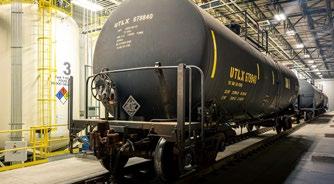
Top Five Export Industries
1. Primary metals
2. Computers and electronics
3. Chemicals
4 Transportation equipment
5. Food and kindred products
Top Five Export Destinations
1. U.K.
2. Canada
3. Japan
4. Mexico
5. Taiwan
Export industries and destinations are for Utah goods.
BUSINESS.UTAH.GOV | @BUSINESSUTAH 85

Broadband
Home to the thriving Silicon Slopes tech corridor, Utah has made great strides in broadband internet deployment and adoption, including robust rural broadband providing remote work opportunities.
High-speed fiber connection to most anchor institutions was expected by 2020 year-end through a partnership between Utah Education and Telehealth Network (UETN) and private broadband providers.
UDOT leads the U.S. with 51% fiber-optic coverage on all state roads and freeways. The agency brings reduced-cost broadband services to urban and rural areas through private/public partnerships.
Awarded more than $28 million in federal USDA ReConnect grant funds during 2019 and 2020, Strata Networks, Beehive Broadband, and Emery Telcom bring additional high-speed fiber to thousands of farms, businesses, and homes covering hundreds of square miles.
Examples of private broadband provider successes across the state include:
• Google selected Provo as the third city for its Google Fiber internet service. The provider has service available throughout the city and now provides service for Salt Lake City customers as well.
• CenturyLink is working to bring broadband to 4,300 rural households in Utah through a Federal Communications Commission grant. They are expanding the current fiber Gigabit service to over 120,000 homes and businesses.
• GoFiber and InfoWest are partnering in Southern Utah, turning up new and existing developments with fiber-optic networks. The companies recently connected internal 100 Gigabit fiber for data transport to multiple data centers.
Data Centers
Utah’s geographic location offers protection from natural disasters like hurricanes, tornadoes, and floods, making the state a perfect spot for large data centers. Utah is home to numerous data centers, including facilities operated by eBay, Twitter, Oracle, the National Security Agency, and Facebook. Washington County is also home to the Tonaquint Data Center, the only Tier II data center between Provo and Las Vegas. In 2017, Strata Networks established a state-of-the-art data center in eastern Utah.


BUSINESS IN UTAH | 2021 86

Quality of Life




Mother Nature played favorites with Utah. The state is home to some of the country’s most beautiful and diverse natural vistas. From The Greatest Snow on Earth ® to the Mighty Five ® national parks, there’s something extraordinary to see and do outdoors in every season.
And that’s not all. The Beehive State offers professional and competitive sporting events, the Sundance Film Festival, state-of-the-art music venues, amazing theatrical experiences, many museums and festivals, unparalleled outdoor recreation opportunities, top-rated restaurants, and much more.
Because of Utah’s natural environment, outdoor recreation and sports, unique heritage and arts, active tourism and film industries — all situated at the Crossroads of the West — the state is not only a great place to do business but also a great place to live.
Come experience Utah’s Life Elevated promise and excellent quality of life for yourself.
44 State Parks
Utah’s state parks are just as stunning as some states’ national parks, with similar vistas and views.
5 National Parks
Utah is home to five national parks, eight national monuments, two national recreation areas, and six national forests.
15 World-Class Ski Resorts
Most of the top-rated resorts are within a one-hour drive from the Salt Lake International Airport.
BUSINESS.UTAH.GOV | @BUSINESSUTAH 87
44 State Parks
5 National Parks
15 World-Class Ski Resorts

Trail System
Utah is home to over 35 million acres of public lands and more than 20,000 miles of trails with 550 access points. Statewide, more than 85% of Utahns live within 15 minutes of a trail head.
Proximity to trails increases property value and strengthens local economies, delivering a recruitment advantage to Utah companies. Just 20 minutes on a trail leads to measurable mental health benefits.
Utah communities with nearby trail infrastructure experience significant physical health benefits, saving $3 in medical costs for
Ideal Climate
Utah boasts a four-season climate with lots of sunshine and low humidity. Mountain ranges protect the Salt Lake metropolitan area from harsh weather while receiving hundreds of inches of The Greatest Snow on Earth®
Utah’s geography includes mountains and fertile valleys, arid deserts, sand dunes, and thriving pine forests.
Average daytime high temperatures range from in January to in July
93 ℉ 37 ℉

Four-Season Recreation
Summer Outdoor Activities

• ATV riding
• Bird and wildlife watching
• Camping
• Golf
• Hiking
• Horseback riding
• Hunting
• Mountain biking
• Road cycling
• Rock climbing
Winter Outdoor Activities

• Cross-country skiing
• Ice climbing
• Ice fishing
• Ice skating
• Skiing
• Sledding and tubing
• Snowboarding
• Snow kiting
• Snowmobiling
• Snowshoeing
Water Activities
Acclaimed Culture
The annual Sundance Film Festival in Park City and Salt Lake City showcases the world’s best independent filmmaking. And, the Tony Award-winning Utah Shakespeare Festival in Cedar City draws more than 125,000 visitors annually to its permanent stages.
Utah’s heritage and arts are on display and on-stage nearly every day.


• Boating
• Fishing
• House-boating
• Paddle-boarding
• Jet skiing
• Kayaking
• Para-sailing
• Scuba diving
• Swimming
• Whitewater rafting

BUSINESS IN UTAH | 2021 88


A Sampling of Utah Attractions
City Creek Center


This unique shopping environment features a retractable glass roof, a creek running through the property, a pedestrian skybridge, and more than 100 stores and restaurants.
Clark Planetarium
The Planetarium features space exhibits, educational shows, and current movie releases in its IMAX theatre.
Lagoon Amusement Park
This family favorite features nearly 50 roller coasters and rides, entertainment, carnival games, and a water park.
Loveland Living Planet Aquarium
The aquarium is home to 4,000 animals and 450 species.
Natural History Museum of Utah
This beautiful museum showcases Utah’s natural history with artifacts, dinosaur exhibits, science displays, and hands-on activities.
Red Butte Garden
The botanical garden and arboretum sits on over 100 acres and hosts many concerts and events.
Temple Square
One of Utah’s top tourist destinations is the iconic Salt Lake Temple and the Church History Museum.
Thanksgiving Point
The institute encompasses multiple museums, gardens, restaurants, activities, and events.
The Leonardo
Leonardo da Vinci’s cross-disciplinary inquisitiveness inspires this interactive science and art museum.
Utah’s Hogle Zoo
The zoo boasts more than 800 animals located on 42 acres.
BUSINESS.UTAH.GOV | @BUSINESSUTAH 89
Natural History Museum of Utah
Red Butte Garden
Professional Sports Teams
Ogden Raptors – Baseball, Pioneer League (Rookie Advanced)
Real Salt Lake – Soccer, MLS
Salt Lake Bees – Baseball, Pacific Coast League (AAA)
Salt Lake City Stars – Basketball, G-League
Utah Grizzlies – Hockey, ECHL
Utah Jazz – Basketball, NBA
Utah Royals – Soccer, NWSL
Utah Warriors – Rugby, MLR
University Sports Teams
BYU Cougars
NCAA Division I – 21 teams
Dixie State Trailblazers
NCAA Division I – 15 teams
Salt Lake Community College
NJCAA – 8 teams
Snow College Badgers
NJCAA – 8 teams
Southern Utah Thunderbirds
NCAA Division I – 17 teams
Utah State Aggies
NCAA Division I – 16 teams
University of Utah Utes
NCAA Division I – 17 teams
Utah Valley Wolverines
NCAA Division I – 14 teams
Weber State Wildcats
NCAA Division I – 16 teams
Westminster College
NCAA Division II – 14 teams


The Greatest Snow on Earth ®
Utah’s Cottonwood Canyons are some of the snowiest places in the world, with resorts topping 500 inches of snow annually. The snow allows for excellent nearby winter activities, such as skiing and snowboarding, snowshoeing, snowmobiling, and snow kiting.
Eight Driving Miles
There are just eight short driving miles between 40 feet of snow per year in the Cottonwood Canyons and five feet per year in Salt Lake City. Enjoy deep powder by day and city life by night.
Magazine Rankings
Readers of SKI magazine ranked Deer Valley the No. 1 resort in North America in 2018.
TransWorld Snowboarding magazine ranked Park City the No. 10 overall resort in North America.
Forbes magazine ranked two Utah resorts as part of its Top 10 ski resorts in North America in 2019:
No. 3 — Snowbird
No. 4 — Alta





Utah Olympic Legacy Foundation
The foundation celebrates the 2002 Winter Games’ spirit by inspiring active, healthy lifestyles and increasing community uses of Utah’s Olympic venues. Designated Official U.S. Olympic Training Sites, these venues allow youth athletes to train alongside world champions.
Utah Olympic Oval
The oval is home to over 100 world records in speed skating. It hosts world-class speed skating races and provides learning programs for aspiring figure skaters, speed skaters, hockey players, and others.
Utah Olympic Park
This 389-acre park is open year-round and home to six Nordic ski jumps, a 1,335-meter sliding track, freestyle aerials, winter training, competition hills, and a 750,000-gallon training pool. The park is also home to a Winter Sports Center and two museums.


Legislative Resolution
In its 2020 legislative session, the Utah Legislature approved a concurrent resolution addressing a future Olympics:
Now, therefore, be it resolved that the Legislature of the state of Utah, the Governor concurring therein, is comfortable with the concepts and principles in the latest winter host agreement documents provided by the International Olympic Committee and would support the state of Utah signing similar host agreement documents for a future Olympic and Paralympic Winter Games.
BUSINESS.UTAH.GOV | @BUSINESSUTAH 91
A Sampling of Performing Arts
Ballet West
One of America’s leading ballet companies
CenterPoint Legacy Theatre
A community musical theater company that also manages an acting, dancing, and singing academy for all ages
George S. and Dolores Doré Eccles Theatre
Hosts touring Broadway shows and other professional performances; seating for 2,468
Hale Centre Theatre
This venue opened in 2017 and includes two theaters: the Young Living Centre Stage with 911 seats (the world’s most technologically advanced theatrical space) and the Sorenson Legacy Jewel Box Stage with 467 seats
Pioneer Theatre Company
Produces major musicals and works by contemporary playwrights
Repertory Dance Theatre
Dedicated to the creation and performance of modern dance
Ririe-Woodbury Dance Company Commissions and performs original dance works
Salt Lake Acting Company
Supports emerging playwrights by commissioning and producing new plays
The Tabernacle Choir and Orchestra at Temple Square Performs each Sunday in Salt Lake City and holds open rehearsals each Thursday night on Temple Square
Tuacahn Center For the Arts
An outdoor professional stage set in the red rocks of St. George hosting family-friendly Broadway productions and seasonal events
Utah Opera
A professional opera company that presents four annual productions at Utah’s Capitol Theatre
Utah Shakespeare Festival
Tony Award-winning festival that presents classic and contemporary plays
Utah Symphony
Performs more than 70 subscription concerts annually in Abravanel Hall
According to the National Endowment for the Arts, 84.5% of Utahns attend performing arts performances in a given year, far more than any other state.




BUSINESS IN UTAH | 2021 92

Arts, Culture and Lifestyle
World-Class Dining

Salt Lake City has been named one of Zagat’s Up-and-Coming Food Cities Around the U.S., thanks to an emerging farm-to-table culture and a growing base of award-winning local producers.

Zagat’s Top 10 Salt Lake Area Restaurants
The Mariposa (Deer Valley)
Garden Café (Salt Lake)
Riverhorse on Main (Park City)
Takashi (Salt Lake)
Glitretind Restaurant (Park City)
Bambara (Salt Lake)
J&C Grill (Park City)
New Yorker (Salt Lake)
Log Haven (Salt Lake)
Goldener Hirsch Restaurant (Park City)
AAA Four-Diamond Award-Winning Restaurants
Val ter’s Osteria (Salt Lake City)
Three Room at Sundance Mountain Resort (Provo)
Edge Steakhouse (Park City)
Riverhorse on Main (Park City)
Apex Restaurant (Park City)
Goldener Hirsch Restaurant (Park City)
J&G Grill at St. Regis Deer Valley (Park City)
The Mariposa (Park City)
AAA-Four Diamond Award-Winning Hotels
Blue Boar Inn (Midway)
Hoodoo Moab (Moab)
Goldener Hirsch Inn (Park City)
Hotel Park City (Park City)
St. Regis Deer Valley (Park City)
Washington School House (Park City)
The Inn at Entrada (St. George)
Grand America Hotel (Salt Lake City)
Kimpton Hotel Monaco (Salt Lake City)
AAA-Five Diamond Award-Winning Hotels
Montage Deer Valley (Park City)
BUSINESS.UTAH.GOV | @BUSINESSUTAH 93


Plan a Visit to Utah
Visit Utah visitutah.com
Ski Utah skiutah.com
Salt Lake Downtown Alliance Map of Downtown Nightlife downtownslc.org/nightlife
Now Playing Utah — Utah’s cultural events calendar nowplayingutah.com
Utah Olympic Legacy Foundation utaholympiclegacy.com
Experience Arts Salt Lake — Abravanel Hall, Capitol Theatre, Eccles Theater, Rose Wagner Performing Arts Center artsaltlake.org/events
REV210901










 Spencer J. Cox Utah’s 18th Governor
Spencer J. Cox Utah’s 18th Governor



 Dan Hemmert Executive Director
danhemmert@utah.gov
Dan Hemmert Executive Director
danhemmert@utah.gov
 Dan Hemmert Executive Director Governor’s Office of
Dan Hemmert Executive Director Governor’s Office of




























 By: Allie Russell
By: Allie Russell













 By: Rachelle Ackley
By: Rachelle Ackley












 By: Utah Inland Port Authority
By: Utah Inland Port Authority























































































 David Carlebach, Vice President of International Investment for World Trade Center Utah
David Carlebach, Vice President of International Investment for World Trade Center Utah

































































